Contents
- Message from the Associate Director
- Professor Jim Ginther, CMS Associate Director
- International Opportunities
- Joint Educational Placement Program: Ariana Sider, Álex Bermúdez Manjárres, and Mary Maschio
- International Visiting Graduate Student Program: Francesca Chiodo
- Brass Rubbings Collection
- Amy Bridges, Jordan St Augustine, Bard Swallow
- Alumni Spotlight
- Anna Wilson
- 2025-2026 Alumni Programme
- Cologne-Toronto Graduate Student Colloquium
- Summer Latin
- Accomplishments
- Recent Publications, Student News, Alumni News
- Lectures & Events
- Winter 2025 photos / Spring 2025 Lectures
- In Memoriam
- Walter Goffart, by Andrew Gillett
additional contributors: Elisa Brilli, Gwen Burrows, Brianna Daigneault, Greti Dinkova-Bruun, Emma Gabe, Kara Gaston, Shami Ghosh, Ann Hutchinson, Graham Johnson, Dorothea Kullman, Liz Lourenco, Mariana Mota Prado, Alexander C. Murray, Monika Schausten, John Schectman-Marko, Joseph Wong, Rui Xu
Message from the Associate Director
From its inception in 1964, the Centre for Medieval Studies has fostered an international vision. Many of the Centre’s faculty, students, and visiting scholars come to Toronto from various parts of the world to collaborate in research and teaching, and we have thus created a centre of learning that draws from the very best of so many nations. We have been, as a result, forming students in both the MA and PhD programs whose scholarly vision is not limited by borders or language. In this respect, the Centre mirrors the desire of many Canadians to be engaged with the world beyond our borders. Excellence in scholarship never flourishes in isolation, but is rather enhanced by exposure to, and engagement with, scholars and students from the Americas, Europe, Asia, Oceania, and Africa.
For over a decade, one way that the Centre has maintained its commitment to international scholarship has been the Graduate Colloquium, jointly sponsored by the Centre and the a.r.t.e.s. Graduate School and the Zentrum für Mittelalterstudien (ZEMAK) of the Universität zu Köln. Founded in 2013 by Emeritus Professor and former CMS Director, John Magee, in partnership with Professor Andreas Speer of the Cologne Centre for the Humanities, this colloquium has brought together doctoral students from both universities to present their research in progress. This February, Cologne was the host, allowing six of our students to present papers followed by commentary from Cologne Faculty. Álex Bermúdez Manjárres, Gregory Carrier, Brianna Daigneault, Jamie St. Clair Collings, Rui Xu, and Zina Uzdenskaya travelled to Germany, with six CMS Faculty who acted as respondents to the papers presented by the Cologne students: Dorothea Kullmann, Martin Pickavé, Bert Roest, Giulio Silano, Sebastian Sobecki, and myself. The quality of every paper was outstanding, and each session brimmed with insightful questions with suggestions on how to further hone the student’s research.
The Toronto-Cologne Graduate Colloquium is just one opportunity for CMS students to engage in international scholarship. For the last two years, the Centre has increased its funding of international travel for students presenting papers at a conference or engaging in archival research. Additionally, five of our doctoral students are currently enrolled in a Joint Educational Placement program, working with scholars at a university in another country alongside their doctoral committee here in Toronto. The spring Chronica showcases many of these international initiatives, introduces the 2025-2026 Alumni Programme, and recounts the year’s happenings throughout the medieval community.
- Professor James Ginther, Associate Director, CMS

International Opportunities
Over the last few years, CMS has dramatically increased opportunities for doctoral students to study abroad. While CMS students have always had the chance for intercontinental research travel, the Joint Educational Placement (JEP) frame – similar in spirit to a European cotutelle – provides the administrative tool to augment these stays, and transform them into a true collaboration among scholars and institutions, while also ensuring a deeper academic experience for Toronto students.
- Kara Gaston, PhD Coordinator
PhD Candidate, Ariana Sider explores the sensory, spatial, and material parameters of lay Christian death in late-medieval French towns. Her JEP allows her to research the spatiality and materiality of late-medieval commemorative practices at both U of T and the Université de Fribourg, under the supervision of two distinct supervisors.
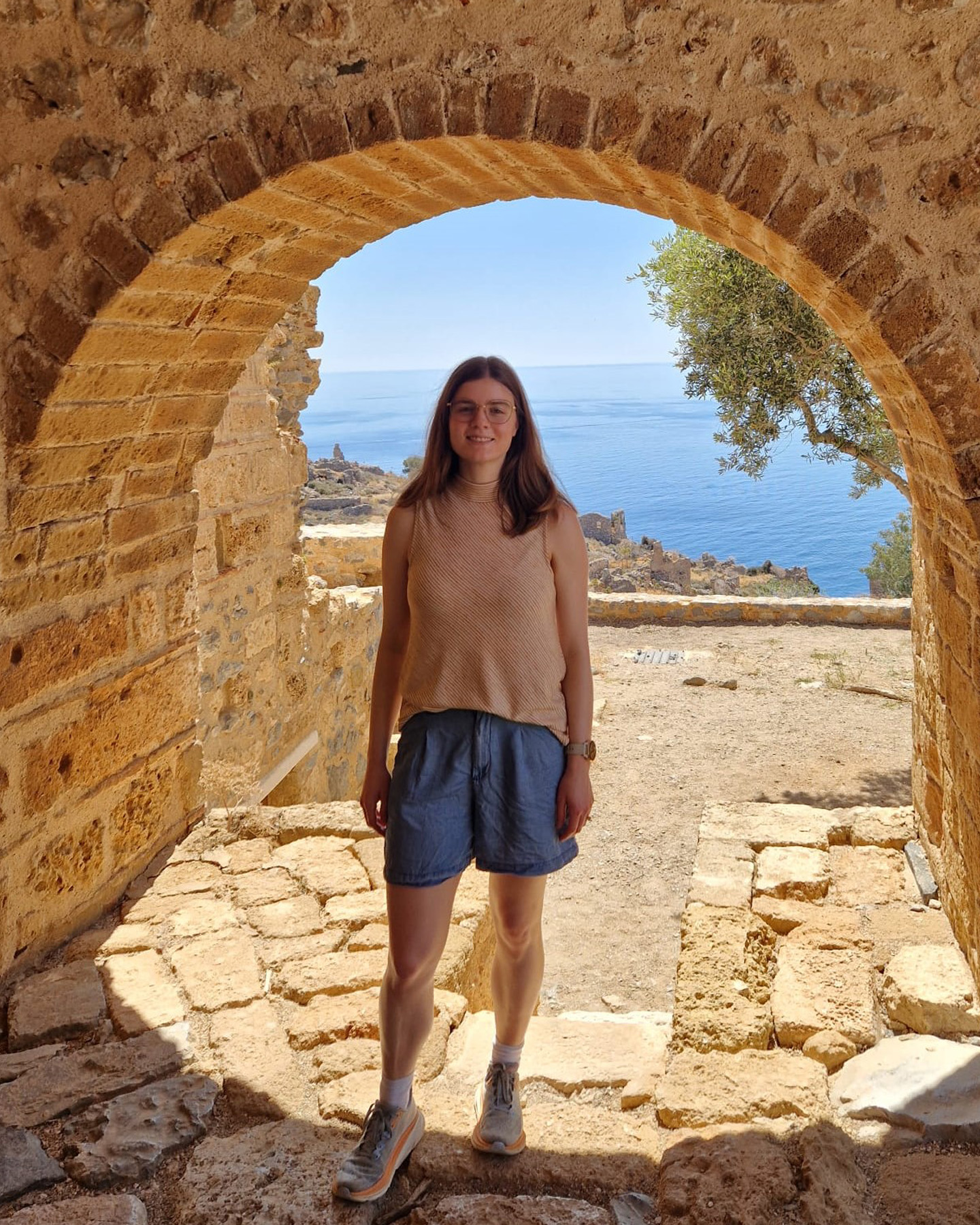
What made you want to pursue a JEP?
Professor Dorothea Kullmann encouraged me to consider a JEP, and after some research, I knew that it would greatly enrich my doctoral experience. I opted for Fribourg because I was familiar with Professor Olivier Richard’s excellent scholarship on late-medieval German wills, and I was also intrigued by the university’s multilingual environment, excited to join the Medieval Studies Institute’s vibrant community of medievalists.
How does studying at two institutions contribute to your doctoral research?
My committee members, Shami Ghosh and Heidi (Toronto, co-supervisor; Toronto, squirrel expert), Olivier Richard (Fribourg, co-supervisor), and Nicholas Terpstra (Toronto, committee member) have been very generous with their time. They have provided extensive feedback on my written work (in Heidi’s case, encouraging barks) and are always willing to discuss any questions that may arise as I conduct my research. Their wealth of knowledge and encouragement are certainly the most important resources at my disposal!
I have also benefited from many thought-provoking discussions with friends and colleagues, particularly Jack McCart, who is as (if not more) obsessed with late-medieval wills as I am, and Gregory Carrier, whose research on the theological underpinnings of medieval sensory culture has inspired me to ask new questions. At Fribourg, I am particularly grateful to Hippolyte Souvay, who assisted with my Heurist relational database.
Having Professors Ghosh and Richard as co-supervisors has compelled me to think deeply about my methodological approach to scholarship—how growing up and being educated in Canada has shaped the historical questions that I pose. I have benefited from numerous discussions with Professor Ghosh on olfactory experience in India, while Professor Richard has helped me expand my methodological toolkit. Ultimately, working with people from different backgrounds with different lived experiences has enriched my work immensely.
How were you supported during the application process?
I am grateful to Professor Kullmann, who encouraged me to initiate the process, as well as to Agnès Boutreux, whose experience in French academia helped me decide to contact Professor Richard. My co-supervisors patiently responded to many emails and paperwork, providing encouragement throughout the application process. Graduate Administrator Terry Louisy and Professors Kara Gaston and Jenny Purtle (CMS PhD Coordinators) were instrumental in managing the administrative aspects, and Nathalie Rappo at the Université de Fribourg and Professor Elisa Brilli gave their time and tenacity in seeing this through. My JEP would not have come to fruition without their unrelenting efforts!
Do you have any advice for CMS Students who are interested in pursuing joint educational placement?
Start the application process as early as possible, preferably in your first year!
"It's been a delight working with Ariana, whom I first met even before she started her MA with us in 2018. I can't wait until she's a professor, teaching classes with her three Bernese Mountain Dogs by her side. Given her interests and her fluency in French, it seemed like an excellent idea for her to spend a year in a Francophone European university. Professor Richard's work was well-known to me, and he has been amazingly supportive and engaged throughout."
- Shami Ghosh, Associate Professor, CMS
A Joint Educational Placement (JEP) is a program that allows students to pursue a PhD under cooperative supervision of their home department along with a collaborating Canadian or international university.
Álex Bermúdez Manjárres, CMS PhD Candidate, analyzes Petrarch’s Latin letters, investigating their role as a medium for self-representation and intellectual self-fashioning. Working towards his dissertation, “Collecting the Self: Petrarch’s Latin Letters and the Self-Writing of a Late Medieval Intellectual”, through a JEP at U of T and L’École des hautes études en sciences sociales has provided him with increased access to intellectual, institutional, and archival resources.

What made you want to advance in your graduate studies simultaneously at two universities?
Pursuing a JEP was initially not part of my plans, but my CMS supervisor, Professor Elisa Brilli suggested it as a worthwhile opportunity. This experience has allowed me to broaden my perspective on medieval studies by engaging with different academic traditions. Studying at two institutions has been incredibly enriching. A key benefit is the opportunity to connect with a diverse network of scholars and future colleagues, which has been formative both intellectually and professionally. Working with my co-supervisor, Étienne Anheim, a historian and leading Petrarch specialist, has been particularly rewarding, as his expertise directly addresses the needs of my research. The JEP has proven to be an exceptional opportunity for my academic growth; the experience of working within another academic tradition, building international connections, and earning a degree from two institutions is truly transformative.
What opportunities and resources have you been provided due to your JEP?
The guidance and expertise of faculty at CMS and ÉHESS Paris have been essential. At CMS, I benefit from the interdisciplinary environment, where a wide range of scholars specializing in the Middle Ages from various fields provide diverse perspectives that enrich my work. At ÉHESS, I can engage with a more theoretical approach, which complements the textual focus of my research and helps me refine my methodological framework. Also, the libraries at both institutions are indispensable. The U of T library system has been exceptionally supportive, even while I am abroad, by providing access to scanned chapters and facilitating interlibrary loan requests for rare or hard-to-find materials. In Paris, the libraries are unparalleled, particularly for their collections of manuscripts and early printed books, which are crucial for my work on Petrarch’s Latin letters.
Working within two distinct academic traditions has exposed me to diverse methodologies and approaches, broadening my perspective and enhancing the depth of my work. Earning a PhD granted by two prestigious institutions strengthens my CV and prepares me to navigate the complexities of the academic job market. My ultimate goal is to pursue a career as a researcher and professor, and this JEP has been instrumental in building the foundation for that path.
How were you able to navigate the process?
CMS and U of T have been incredibly supportive. Not only did I receive a mobility grant, but I had immeasurable administrative support in navigating the complexities of the JEP approval process. The expertise of Professor Brilli, along with the resources and opportunities provided by both institutions, has made this JEP a life-changing experience for my academic and professional development. Students interested in pursuing a JEP, don’t hesitate—it’s an incredible opportunity for academic and personal growth.
"I am delighted with this agreement, which is a project funded by the U of T / CNRS Research Collaboration Program, sponsored by the VP International. While a stay abroad is usual for CMS students, a JEP takes place within an institutional frame that allows participants to gain an insider’s perspective on other universities. This is a great opportunity for our students and our scholarly community. JEPs enable us to shape an even more international future in which Toronto’s medieval studies fully play their role as the bridge between European and North American traditions."
- Elisa Brilli, Professor, Italian Studies / Director, CMS
In addition to the exceptional scholarship that can be gained from the expertise and guidance of two supervisors, students studying concurrently at a second university can benefit from further collaborations and professional connections, and a wider range of postgraduate opportunities. JEP students are able to take advantage of increased access to research events, information centres, and academic perspectives.
Mary Maschio, another of the Centre’s PhD Candidates and JEP program participants, is a scholar of Byzantine Studies and Old French Literature. Mary studies jointly at U of T and the École Pratique des Hautes Études (EPHE), taking advantage of each institution’s distinct opportunities.
How does studying under Joint Educational Placement uniquely enhance your research?

The aim of my dissertation, entitled “Material Culture in French and Byzantine Courtly Literature (1130-1165),” is to provide a detailed and nuanced comparison of the narratives of love and adventure that were composed during the mid-twelfth century in northern France and in Constantinople. This near- simultaneous (re)birth of romance has attracted the interest of numerous scholars, but there is as yet no monograph devoted to the subject.
One of the main challenges to producing such a book is the traditional disciplinary division between Western Medieval studies and Byzantine studies. My JEP between the University of Toronto and the École Pratique des Hautes Études (EPHE) in Paris has been crucial in helping me to overcome this divide. Under the joint supervision of Professor Dorothea Kullmann, a specialist in Medieval French, and Professor Vincent Déroche, an expert in Byzantine culture, I have been able to pursue training in both areas and to remain up to date with important scholarship in both fields.
The two institutions likewise offer complementary resources. At the University of Toronto, I can benefit from the library collection at the Pontifical Institute of Mediaeval Studies, whilst in Paris, I am better able to pursue research on the Greek romances at the Bibliothèque Byzantine du Collège de France.
How do you recommend applying for a JEP?
Both of my supervisors were hugely supportive during the process, and I am especially grateful to Professor Kullmann for all of her work in the administrative navigation. CMS offered not only assistance, but encouragement through the process, and I would highly recommend the Joint Educational Placement program to any student at the University of Toronto who feels that their research would benefit from joint supervision.
"Mary extended her stay in Paris (initially intended to last one year), in order to benefit from the extensive resources, especially in Byzantine Studies, she has access to there. We stay in virtual contact, and occasionally meet at conferences, or when I am in Paris for my own research. I am glad to see that she is not only making good progress on her thesis but also wrote an article in French, which will shortly be published."
- Dorothea Kullmann, Associate Professor, CMS / French
For more information about the JEP, and other visiting and exchange opportunities, visit https://www.sgs.utoronto.ca/resources-supports/visiting-exchange-opportunities/jep.
The International Visiting Graduate Student (IVGS) Program provides an opportunity for international graduate students to study under a U of T supervisor during a short-term visit to the University of Toronto, benefiting from its research facilities, resources, and events, and making connections with a new academic network. Francesca Chiodo, PhD Student at the Università degli Studi di Siena, participated in this program under the supervision of Greti Dinkova-Bruun (PIMS / CMS) at the Centre for Medieval Studies, mutually enriching both institutions.
The IVGS program is an opportunity not only for visiting students to benefit from U of T’s stellar faculty expertise, libraries, community, and resources, but also a chance for the University to cultivate research relationships and foster future collaborations with institutions worldwide.
- Professor Joseph Wong
Vice President International
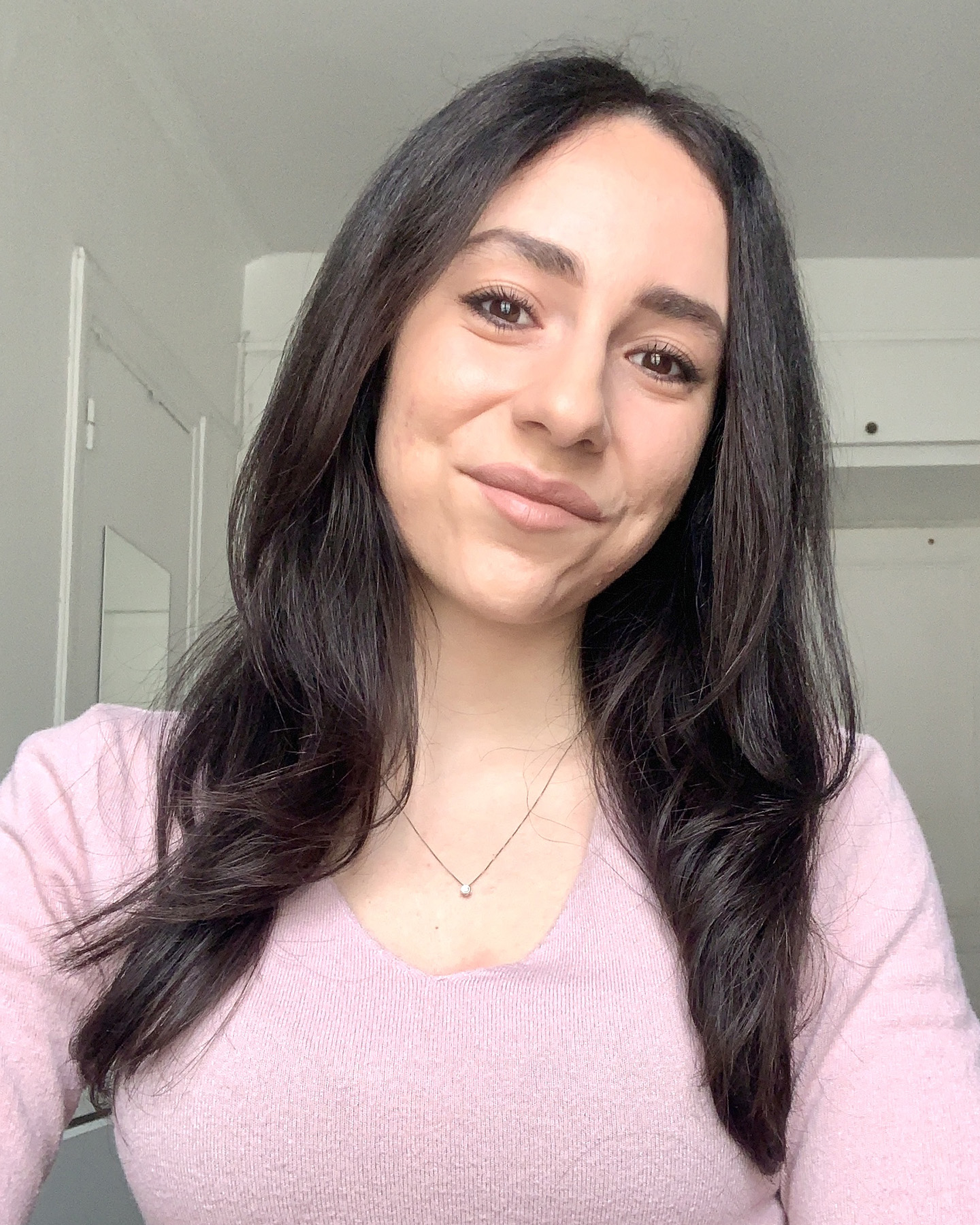
Since the moment I started writing my PhD project on creating an editio princeps of Historie veteris testamenti by Leonius of Paris, a biblical poem of over 14,000 Latin hexameters, I discovered that the leading scholar on this unpublished work was Professor Greti Dinkova-Bruun. Upon starting my PhD in Siena, together with my supervisor Professor Francesco Stella, who was already well-acquainted with Professor Dinkova-Bruun, I considered the idea of spending part of my research stay abroad in Toronto. This plan became a reality when I met Professor Dinkova-Bruun in Florence. She was incredibly proactive, supportive and enthusiastic about my research, which encouraged me to plan my departure with excitement.
Shortly after, I was fortunate to meet Professor Elisa Brilli in Siena, who provided invaluable assistance in finalizing the arrangements for my stay and kindly invited me to the Centre for Medieval Studies. I had imagined that as a visiting international student I would have the opportunity to experience something unique, but the result far exceeded my expectations. I felt welcomed into an inspiring academic environment that allowed me to work productively on my research, attend the prestigious library and the fascinating seminars at the Pontifical Institute of Medieval Studies, and audit two interesting CMS courses, all of which gave me the chance to experience life as a full student at the Centre, and to meet wonderful professors and students whose impact I will carry with me. I will always be grateful for this experience and I sincerely hope to one day return.
- Francesca Chiodo, Università degli Studi di Siena
"During her stay in Toronto, Francesca worked diligently on the critical edition of the Historie veteris testamenti of Leonius of Paris, while also auditing classes at CMS and attending the PIMS research seminars. We met regularly to discuss her project, devising editorial strategies and analyzing the general context for the creation of the poem. It was a pleasure to work with Francesca, and I am looking forward to the final version of her PhD thesis."
- Greti Dinkova-Bruun, Fellow and Library Director, PIMS / CMS Faculty
Visit https://www.sgs.utoronto.ca/future-students/international/international-visiting-graduate-students for information on IVGS, including the wealth of resources and support that are available through the Centre for International Experience and the School of Graduate Studies.
International Visiting Graduate Student
Brass Rubbings
Between the 13th and 17th centuries, Western Europe was introduced to new funerary art in church tombs and cemeteries. Traditional statue memorials were replaced with large flat brass plaques, decorated with heraldic and religious icons, such as ladies, knights, and coats of arms. Reproducing these commemorative plates by rubbing graphite or wax on light kraft paper has become known as brass rubbing.
Amy Bridges and Jordan St Augustine took part in U of T’s Work Study program, spearheading the cataloguing and exhibition of the Centre’s collection of brass rubbings donated by Professor Emeritus David Townsend (CMS / English), and by Professor Emerita Ann Hutchison (York University / PIMS / CMS) through her colleague Professor Emerita Cynthia Zimmerman (York University). Amy and Jordan’s work and research will culminate with a formal presentation and a digital exhibition, creating a legacy for medievalists, researchers, and the community.
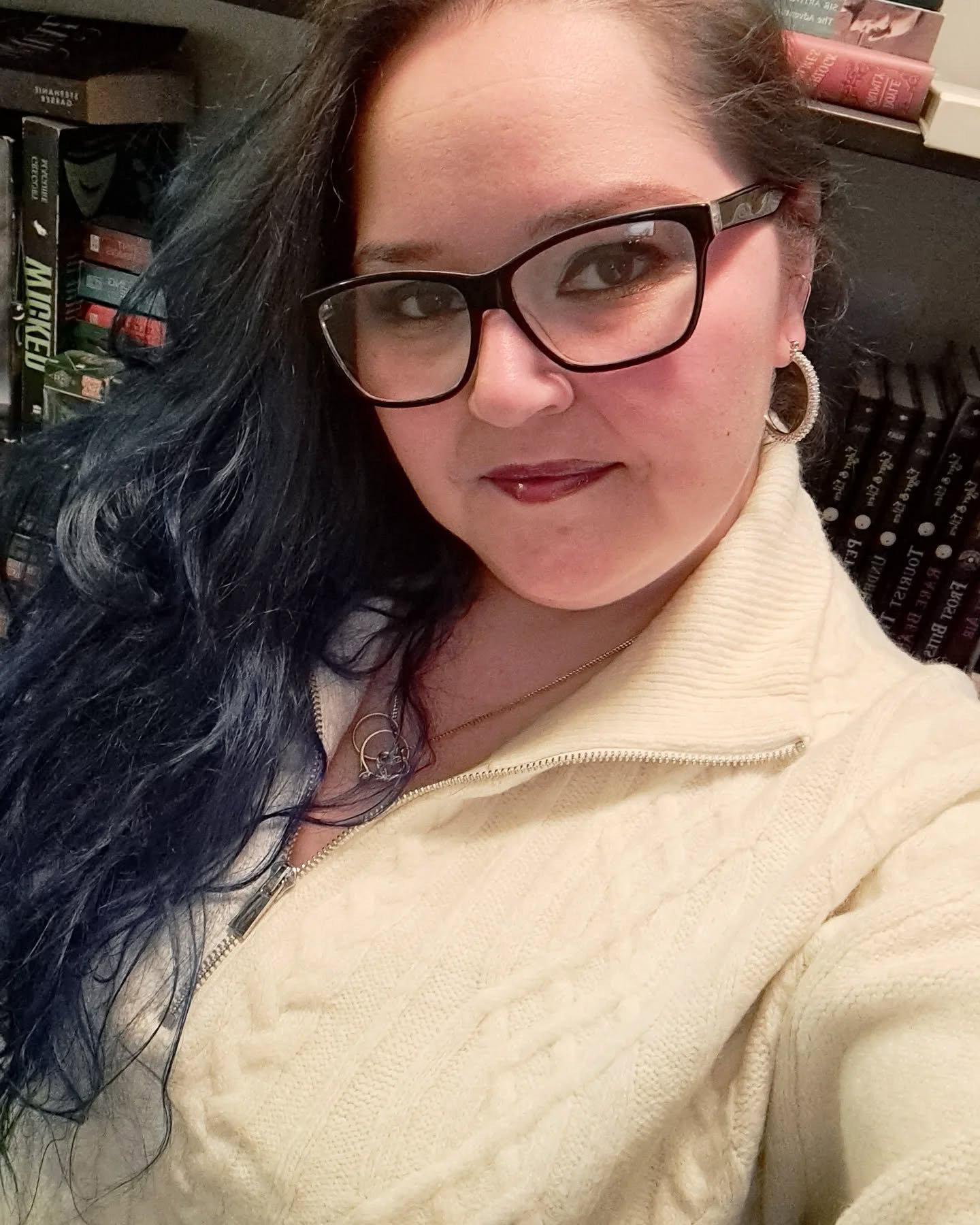
Amy is about to graduate from the Faculty of Information with a combined Master’s of Information degree with Libraries and Archives and Records Management as the concentration, and a Master’s of Museum Studies. With previous degrees in makeup artistry and in Print and Broadcast Media from Durham College, life changes introduced Amy to a new field
What led you to pursue a master’s degree at U of T?
I ended up at Trent University for Psychology, but I took an Anthropology course and fell in love with it. I participated in an archaeological dig in Oshawa, and I never looked back, completing an Anthropology BA with a touch of Archaeology. I worked for my professor cataloguing the Oshawa dig, as well as a Mayan site in Belize. I realized I could not pick just one civilization on which to concentrate; I loved them all in different ways. I also loved books, so I decided on Museum Studies, and this is what brought me to U of T.
While applying to Psychology at Trent, also on my list was the Mediaeval Studies program at St. Mike’s. I enjoyed medieval things and studied a little medieval history, then as a work study student at CMS, I had the privilege of researching these pieces.
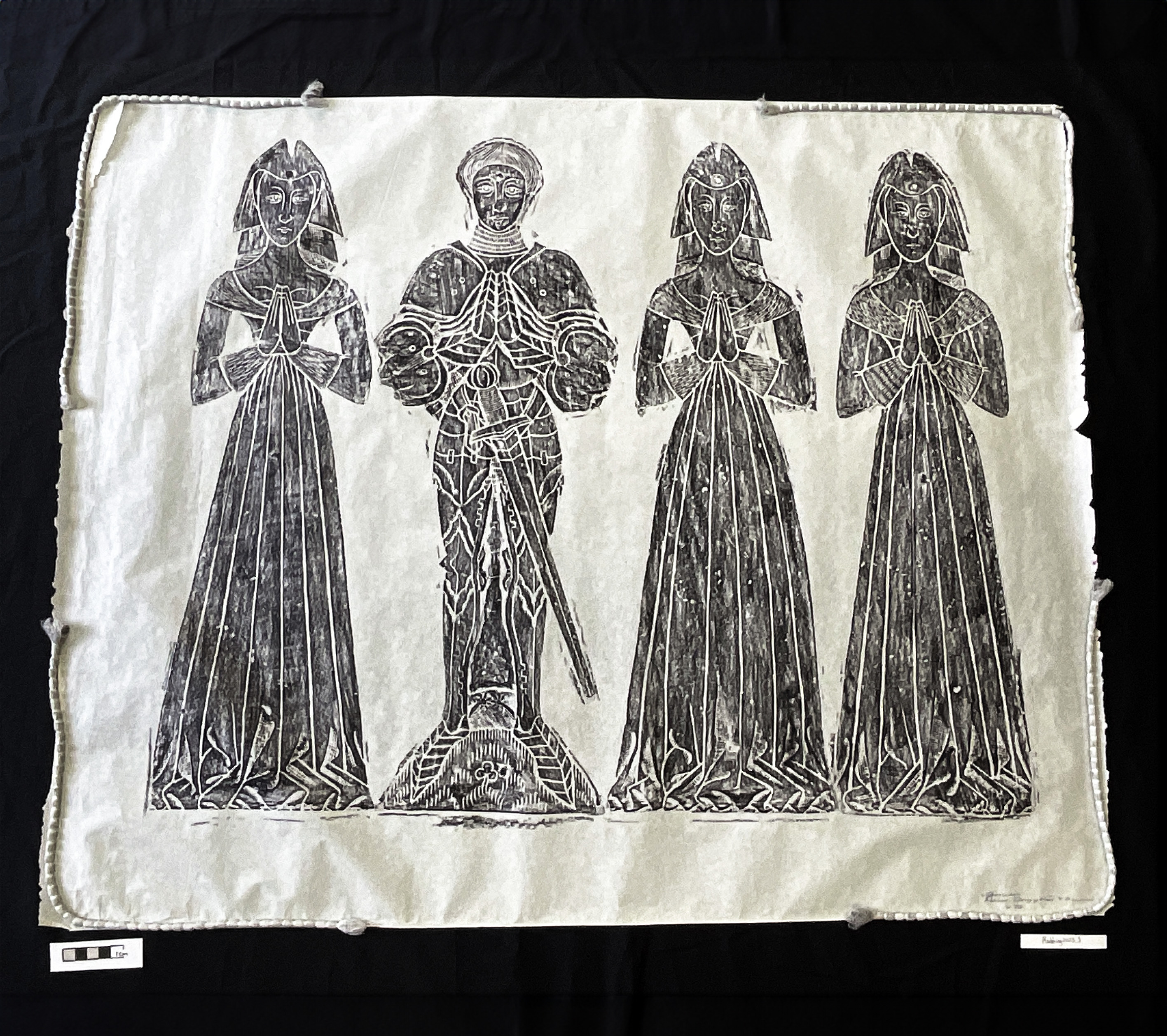
How did you begin your research into the CMS brass rubbings collection, and how did it progress?
I was given a book called Discovering Brasses (Malcolm Cook, Shire Publications, 1977) and read that from front to back. After making notes, I started the digital research, trying desperately to find everybody’s name. Because most of them weren’t titled, I checked their pictorial format against other brass rubbing collections. Using their websites, I researched the Victoria and Albert Museum, different universities with collections, and I found that the Monumental Brass Society has its own website with old papers.
I began creating the catalogue, and wrote out things that I wanted to know about the pieces: their name, what year they were from, and where they were from. I included notes and a description in case they got separated or the name rubbed off, and the size, giving even more points to link them together.
I continued searching, but the first number of rubbings I researched were just unknown, and I was getting very heartbroken. Finally, I found Miss Ann Woode, a woman holding two babies, and that’s when my first happy dance happened. If you’ve seen me researching in a corner somewhere and I jump up and dance, it’s because I’ve found someone’s name.
How did your program at U of T prepare you for this project, and what skills can transfer to future endeavours?
In one of my classes, it was very much impressed upon us that there was a significant difference between small museums and archives, and larger ones that already have resources and catalogues in place. This project really showed that difference, and I was able to adapt, knowing that this is a normal process, and having been shown how to do things from start to finish. U of T helped not only in that aspect but also with all our available resources and libraries.
Some of the pieces were ripped, so using a book repair kit from the British Museum, I was able to keep the paper together and stop it from breaking, but it’s not permanent. This way, an archivist can eventually remove the repair and mesh the pieces together permanently. Fixing pottery at Trent, we used temporary glue, and so I applied that same concept, and I can now combine those two skill sets.
I learned as well, to make sure that my catalogue makes sense to other people, not just myself, so that others can decipher my classifications. Last year, I presented the initial research from these rubbings at the Faculty of Information student conference. I wanted to make sure that people know that cataloguing is more than giving something a number; it’s giving people’s names back. We gave them their name, and that matters. It’s what I have been working very hard to get at.
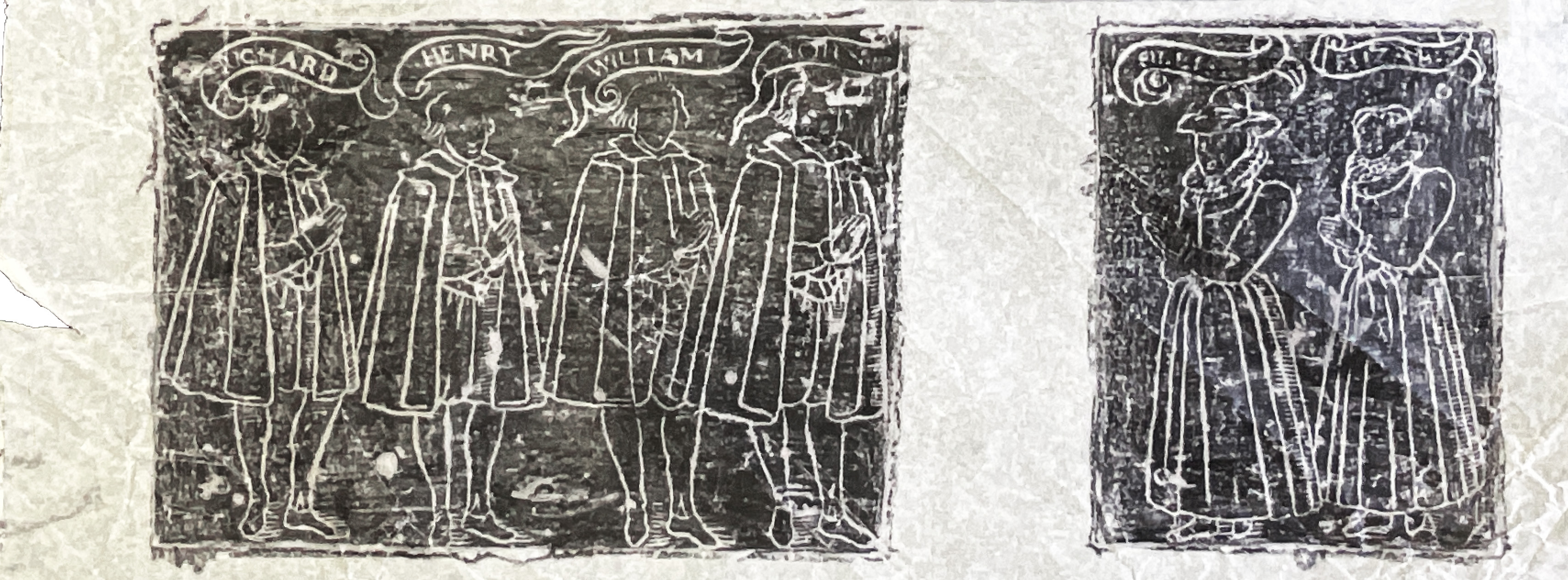
children of John Warren and wife Elizabeth
Jordan is working towards a degree in Master’s Information for Library and Information Science at the Faculty of Information. From programming and information management to English and History, Jordan’s combination of research and experiences led them to U of T, fully prepared to take on this interesting new project.
What prompted you to study Library Sciences?

Leaving high school interested in tech, I studied computer science, then game programming, but recognized it wasn’t for me, so took some time off to tutor English. Realizing that many of those tech certificates are postgraduate, I decided I first needed a degree – any degree – and studied English at York University. I attended a number of “what can you do with this degree”-type workshops, with English being so broad, and I connected with someone who worked at the ROM. This made me think about the other side of the information degree – Museum Studies, and, after some research, I decided I liked the broader study of Library Science, having already had previous experience working in galleries.
Working as a Research Assistant with a History professor at York, I got my start with data management, cataloguing, data cleaning, and discussing archival materials and accessibility. I discovered I really liked information management, and how information literacy tied in with my English degree. I pursued the Library and Information Science concentration because I was interested in both the book and the data side of things, and how they can be combined.
What have you gained from working on the brass rubbings project?
I minored in History at York, but these brass rubbings were completely new to me. With Amy as my coworker, I would ask her to explain all these pieces, and I would get a fantastic mini lecture every time! That’s what is so great about our information major; here is something that I don’t know yet, let me absorb all of this immediately. It’s been really fun learning about something about which I had no idea, and quickly becoming an expert. It’s such a niche little area, and getting to work with new data is always exciting.
It was suggested that we use Omeka as the hosting site and that I work with Professor Alexandra Bolintineanu. She invited me to one of her classes where she was demonstrating how to use Omeka. I was taken aback because it was a PhD-level course, with just two other students, so it was a very intimate experience. It was an environment I hadn’t ever experienced, so it was great to learn what they were researching and to witness those conversations.
I researched how to use Omeka, how other institutions were hosting their online exhibitions, and drew on how we wanted to use it. There was a lot of trial and error and prototyping of uploading, adding the metadata and the photos, connecting with the libraries, and working with the Librarian at UTL. When Amy sends me a file, there are so many different things that you need to search and remove, but that’s data cleaning, and that’s what I’m here for.
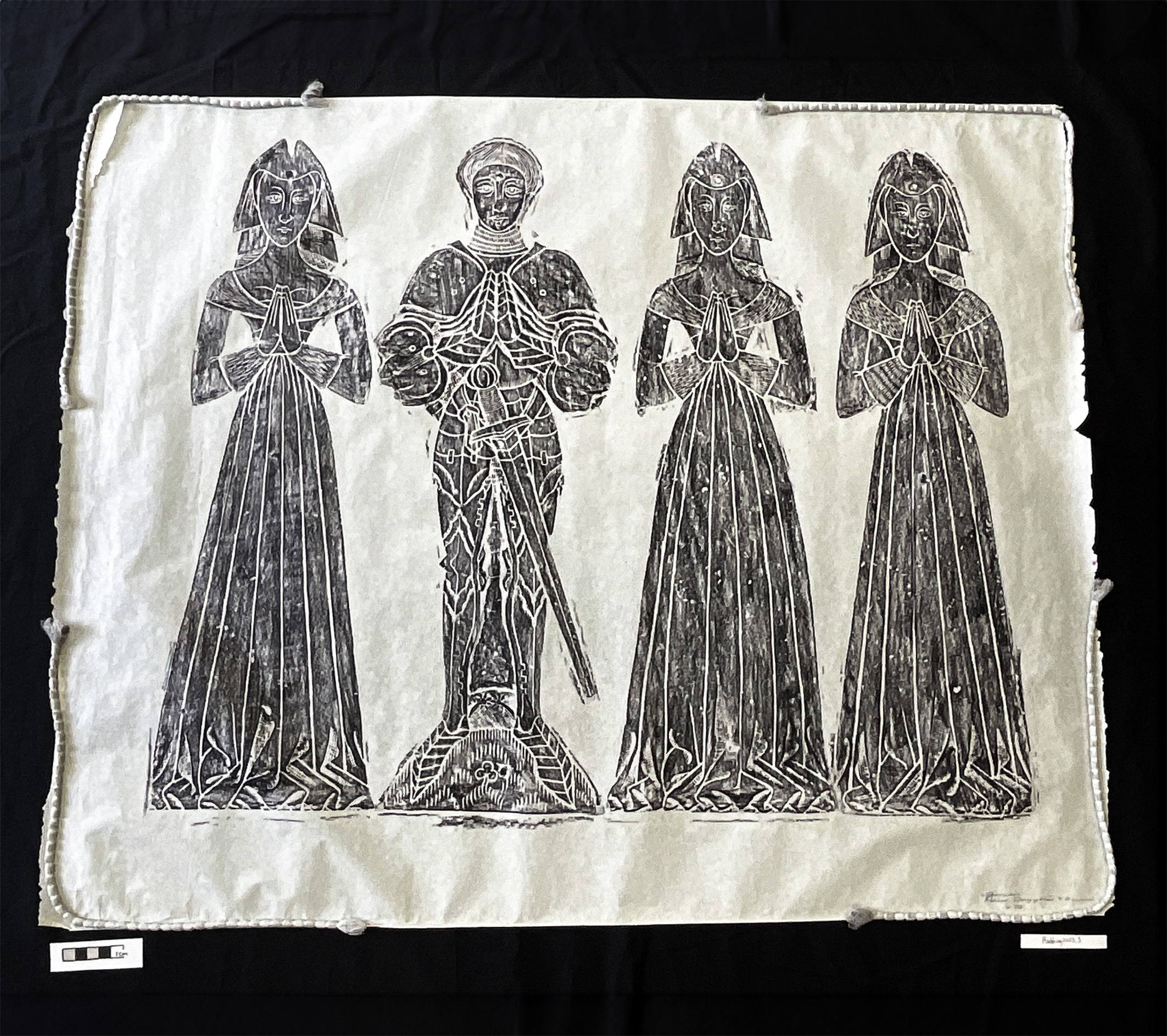
How did your U of T coursework prepare you for this project?
Along with photography and archival wrapping, Amy and I have done some minor repairs to the rubbings. Being part of that process of being able to protect a piece while it awaits its journey to a conservator, I think is really important, and a great thing to put on your resumé. I now have experience not only handling and wrapping archival materials, but I also understand how I can safely and appropriately conserve them.
In one of my courses, "Representing, Documenting, and Accessing the Cultural Record", we examine how people learn and want to find information, and that they usually prefer the path of least resistance. I wanted to incorporate that theory of easily giving people the resources to fully understand and appreciate these pieces. We discussed metadata and why it’s important, and that helped inform what we wanted for the online exhibition. We want to be able, as researchers and as cataloguers, to provide people with the same knowledge base, for instance by providing information about the geography and the history, and by creating a glossary.
U of T has also informed how I’ve approached the work study. We’re part of the project management and planning timelines. Joining a project already in progress, I’m able to quickly acclimate to something outside of my major, and I think that’s a great skill to have, especially as a librarian.
What are your thoughts on the legacy of this project?
Being able to say we made something and to have it on our portfolio is absolutely incredible. And, I’m very on board with Amy’s sentiment of making sure everyone has their own name and entry, especially with couples. Typically, the entry is named after the man, and that is the only identifier. Naming each figure and making sure everybody is treated equally is something that’s really important as a cataloguing procedure. I’m just very on board with that for sure.
Amy Bridges and Jordan St Augustine will present a showcase of the CMS Brass Rubbings Collection and discuss their work on Friday, April 4 prior to the Annual Alumni Lecture. Join them in the Great Hall at 1:45 pm to witness the outcome of their superb research.
Visit the online exhibit at cmsbrassrubbingcollection.omeka.net/exhibits/show/cms_brass_rubbing_collection.
Brass Rubbings Online Exhibition
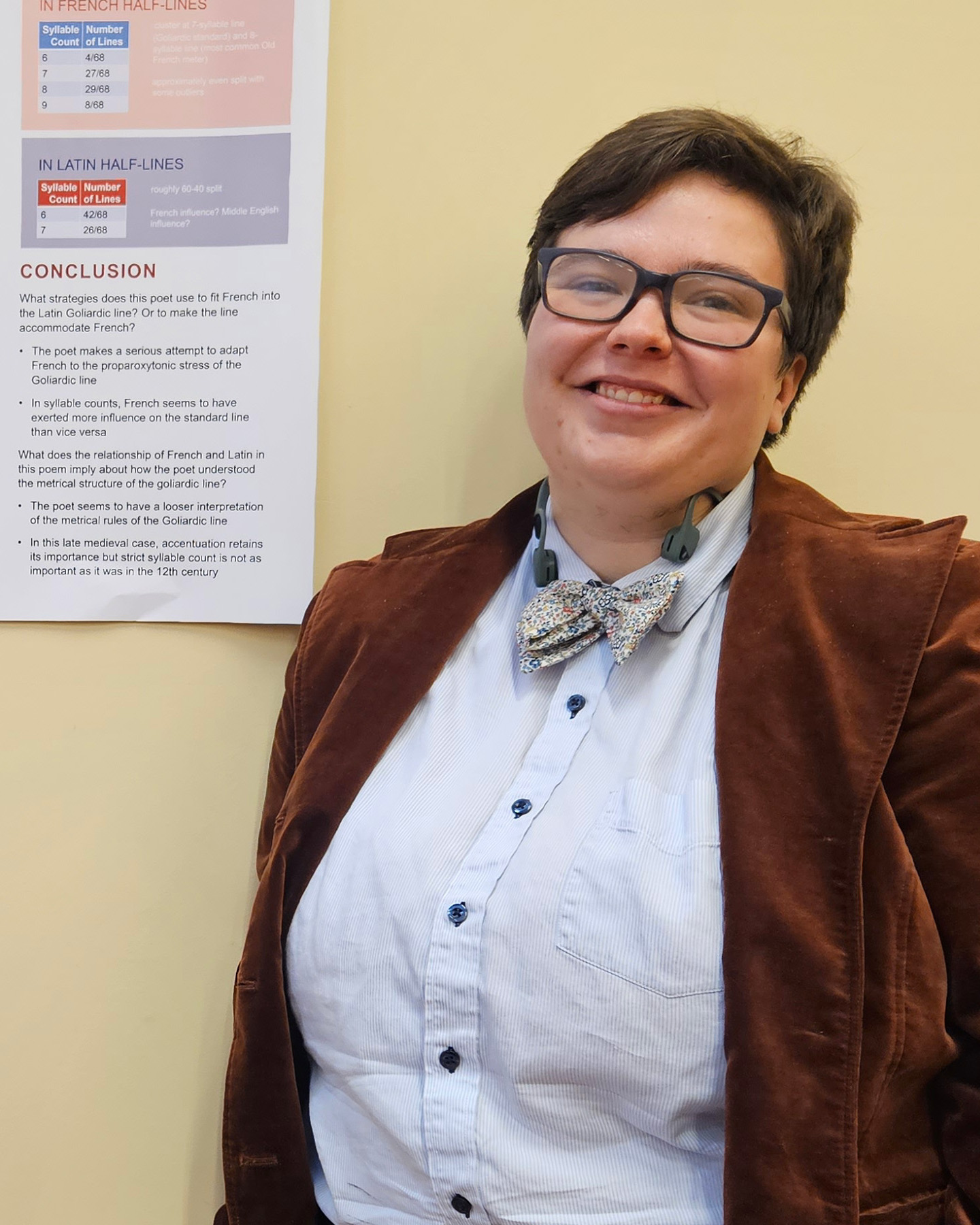
CMS PhD Candidate Bard Swallow studies Latin poetry in late 14th-century England. With a chance re-discovery of the collection, and an interest and training in medieval and modern languages, Bard is recognized as a unique collaborator on the Brass Rubbings project.
Can you describe your discovery of the collection, and your involvement with the project?
When I was helping Professor Townsend clean out his office in 2022 (long before monumental brasses became part of my research), I came upon a poster tube full of brass rubbings. David encouraged me to keep them, and I brought them home along with many of his books. Later that year, when the department was considering options for renovating the Great Hall, I mentioned that I had the rubbings and that we could use them to provide more medieval flavour to the space, which sparked this work study project.
I contributed to the project by transcribing and translating the Latin, French, and Middle English texts attached to the brass rubbings. When our rubbings were not sharp enough or there were oddities with the translations, I consulted other rubbings of the same brasses hosted online and some articles in the Transactions of the Monumental Brass Society.
How does your research intersect with this project?
My dissertation work has made me very familiar with the formulas and conventions of inscriptions on monumental brasses in England, especially those in verse, and with the literature on the subject, so I was well-prepared to support the text side of this project.
My research on other brasses equipped me to appreciate these pieces more fully, and to especially consider the brasses that these rubbings represent, rather than just the image itself. It’s exciting to have come full circle, being involved in the beginning and the end of the project, even if only just from the margin. I’m glad they’re getting seen rather than languishing in a tube.
"As someone who has engaged many students in the work study program, I can’t overstate how rewarding my involvement in this particular brass rubbings project has been. These pieces had been hidden for many years and have now come to light through Amy and Jordan’s work, with help from Bard.
Though I am mainly involved in the administrative and budgetary side of such projects, I unexpectedly learned about brass rubbings – how they should be repaired and conserved, online tools available for digitizing collections, and the stories these pieces tell. Professora Elisa Brilli and Jenny Purtle initiated this idea, and with the guidance and support of Professor Alexandra Bolintineanu, the idea became a reality.
This project is an example of how academic units can provide opportunities to students to deepen their knowledge, strengthen their skills, and explore how their academic studies translate to career possibilities. We look forward to providing more of these opportunities."
- Elizabete Lourenco, Manager, CMS
Learn more about U of T's Work Study program at registrar.utoronto.ca/finances-and-funding/work-study-program.
Alumni Spotlight
Anna Wilson obtained her PhD at CMS in 2015 with a dissertation entitled “Immature Pleasures: Affective Reading in Margery Kempe, Petrarch, Chaucer, and Modern Fan Communities”. Now Associate Director of Undergraduate Studies and Assistant Professor of English at Harvard University, Anna returns for the Annual Alumni Lecture, The Past and Future of Medieval Studies in Ernest Wilkins’ “Letter to Petrarch”.
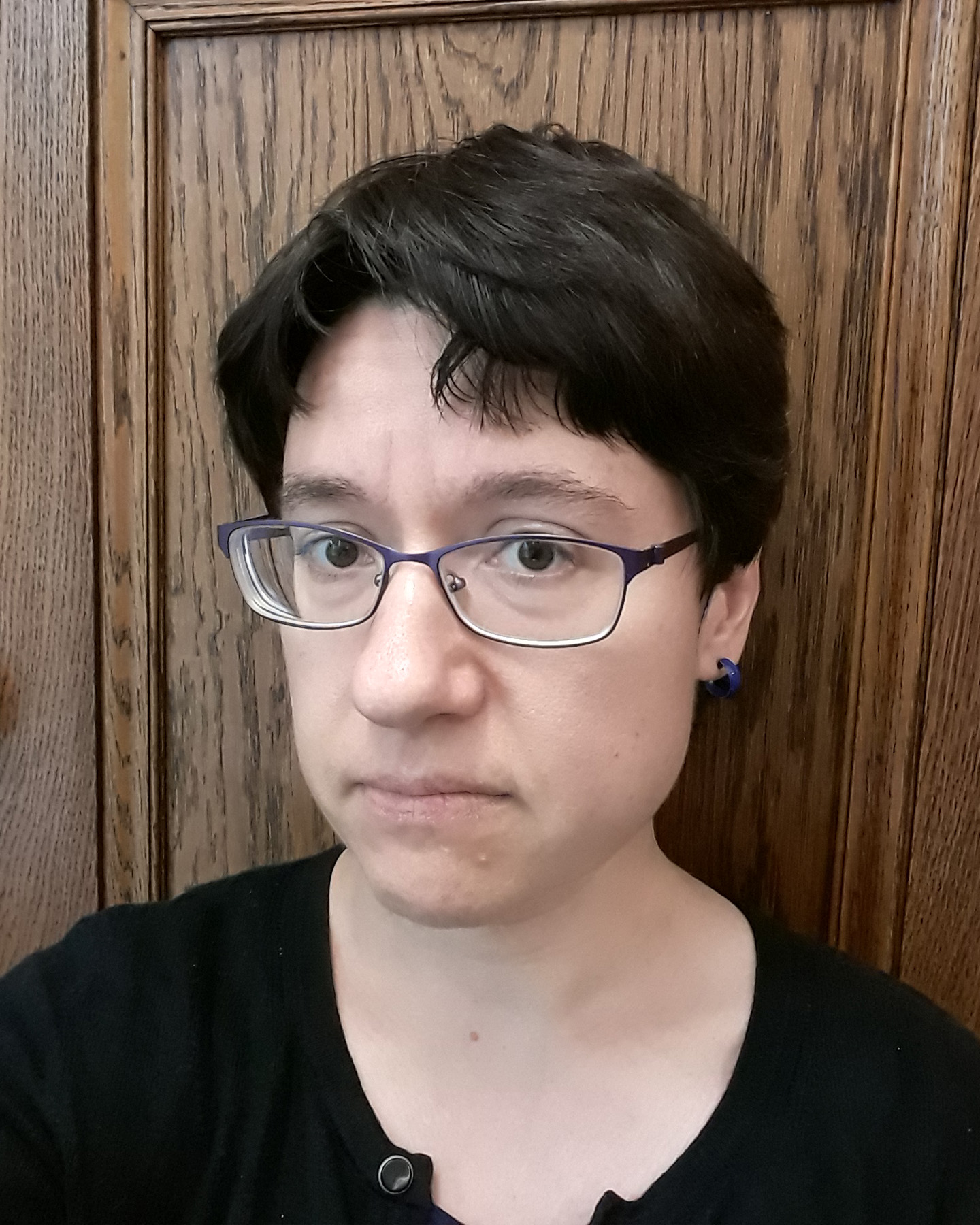
How do you see your time at CMS as a current influence on your research?
I started out as a Classicist, but by the time I came to the Center of Medieval Studies to pursue a master's degree, my interests had shifted into late antiquity and the Christian reappropriation and repurposing of Classical literature. However, in my MA year, I took classes with Professors Jill Ross and David Townsend that completely changed the trajectory of my life. I discovered The Book of Margery Kempe, and wrote an experimental paper on its visionary sections for David’s "Vernacular Spiritualities" class that attempted to bring together my interest in Fan Studies, (which until then had been a hobby) with my longstanding interest in methods of rewriting. That paper became the seed of my PhD dissertation and my forthcoming book, Medieval Fans: Reading, Affect, and Queer Community.
What does it mean to you to deliver this year’s Alumni Lecture?
CMS instilled in me an interdisciplinary identity and a commitment to medieval studies, which combines literary theory with more traditional philological skills like palaeography and Latin literacy. My CMS Alumni Lecture, The Past and Future of Medieval Studies in Ernest Wilkins’ “Letter to Petrarch”, comes out of the final chapter of my book. The text I discuss is an oddity, a Petrarch scholar’s letter to Petrarch, delivered as his presidential plenary to the Medieval Academy of America in 1958. I approach Wilkins’ letter as a sort of microcosmic moment representing the negotiation – at the very centre of the medievalist profession – of the relationship between a fan’s devotion and a scholar’s critical methods.
CMS shaped my conviction that to be a medievalist is to be in community with others. We’re in a moment – yet another moment – of crisis about the boundaries, ideals, attachments, and goals of medievalist community, and Wilkins’ letter, I think, can help us think about that crisis in new terms.
Alumni Programme
Since 1968, CMS Alumni have contributed greatly to the reputation of the Centre as the leading North American institution in its field. In recent years, many additional opportunities have been made available for Alumni to reconnect with the medievalist community, develop collaborations, and enrich the academic lives of current Students. All Alumni, whether working inside or outside of academia, who have completed either an MA or a PhD, are invited to share their experiences and achievements since graduating from the Centre, and mutually benefit from the Alumni Programme.
Participate in the 2025 - 2026 CMS Alumni Programme and learn more at https://www.medieval.utoronto.ca/alumni-friends/resources-alumni-friends/cms-alumni-programme.
MST 1003
Alumni have made a lasting impact on current students by participating in the MST 1003 Professional Development course. Guest speakers share their experiences on topics from funding and academic challenges to alternative careers. Thank you to this year’s guest speakers:
Alessia Berardi (PhD 2023)
Christendom College
Samuel Cardwell (PhD 2023)
University of Nottingham
Andrew Hicks (PhD 2011)
Cornell University
Patrick McBrine (PhD 2008)
Bishop’s University
Laura Moncion (PhD 2024)
University of Notre Dame
Andrew Seeley (PhD 1995)
The Augustine Institute
Jessie Sherwood (PhD 2005)
Robbins Collection
Marianna Stell (MA 2014)
Library of Congress
GUEST LECTURES
With a hybrid option, Alumni are invited to attend our Friday Convivium series virtually or in person, with a lively lunch that precedes each lecture. The Alumni Programme also allows former students to express their interest in becoming a visiting speaker.
MENTORSHIP
CMS Ambassadors are matched with an advanced PhD Student to provide individual mentorship and support, discussing topics relevant to the student’s academic path and professional future.
STAY IN TOUCH
Display your affiliation with your dissertation on the CMS website, promote your publications, events, and accomplishments. Reconnect personally and professionally with not only CMS, but the greater community at U of T.
2025-2026 CMS Alumni Programme
Cologne-Toronto Colloquium
Sponsored jointly by the Centre for Medieval Studies, the Research Training Group (GRK 2212) “Dynamics of Conventionality (400-1550)”, the Zentrum für Mittelalterstudien Köln (ZEMAK), and the a.r.t.e.s. Graduate School for the Humanities Cologne, the Cologne-Toronto Graduate Student Colloquium alternates between the University of Toronto and Universität zu Köln. This February, CMS Students and Faculty travelled to Cologne to participate in the 10th occasion of the conference.
CMS faculty members James Ginther, Dorothea Kullmann, Martin Pickavé, Bert Roest, Giulio Silano, and Sebastian Sobecki made the trip to Germany to engage as respondents to papers delivered by the Graduate Students of Cologne.
Graduate students presented these stimulating papers, which resulted in invigorating analysis and discussions.
Gregory Carrier Finding Paul Within: Berthold of Reichenau’s Pauline Interpretation of Herman of Reichenau’s Disability
Jamie St. Clair Collings The ‘penitential’ adoption of classical materials in 12th-century Cistercian meditative thought
Brianna Daigneault Riddling the Physiologus
Álex Bermúdez Manjárres The position of Petrarch in the context of 14th-century Latin letters production
Zina Uzdenskaya Crafting Sacred Images: Depicting Becket’s Martyrdom on Limoges Reliquaries
Rui Xu Henry of Ghent on the Grounds for Possibility and Impossibility
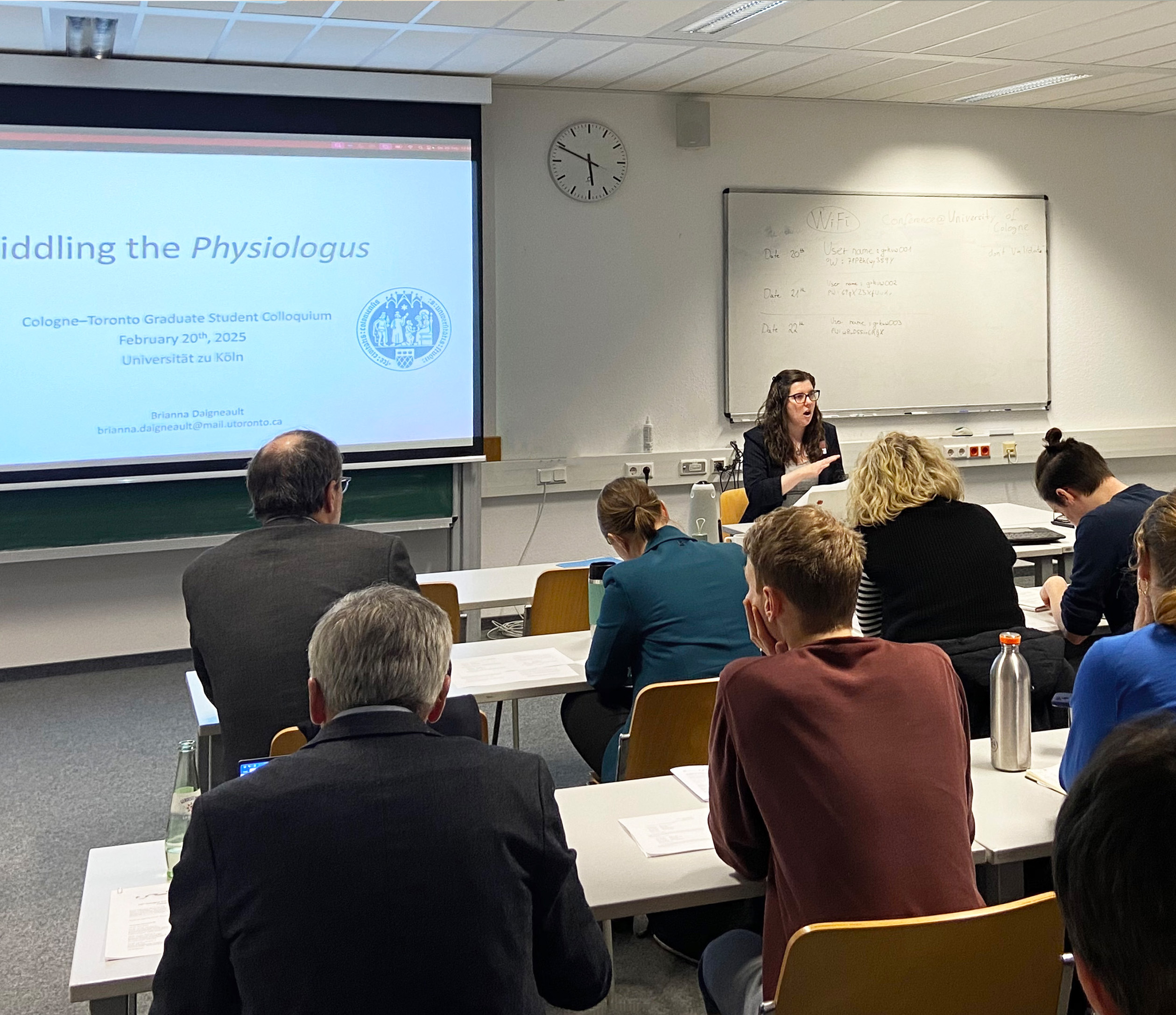
Brianna Daigneault
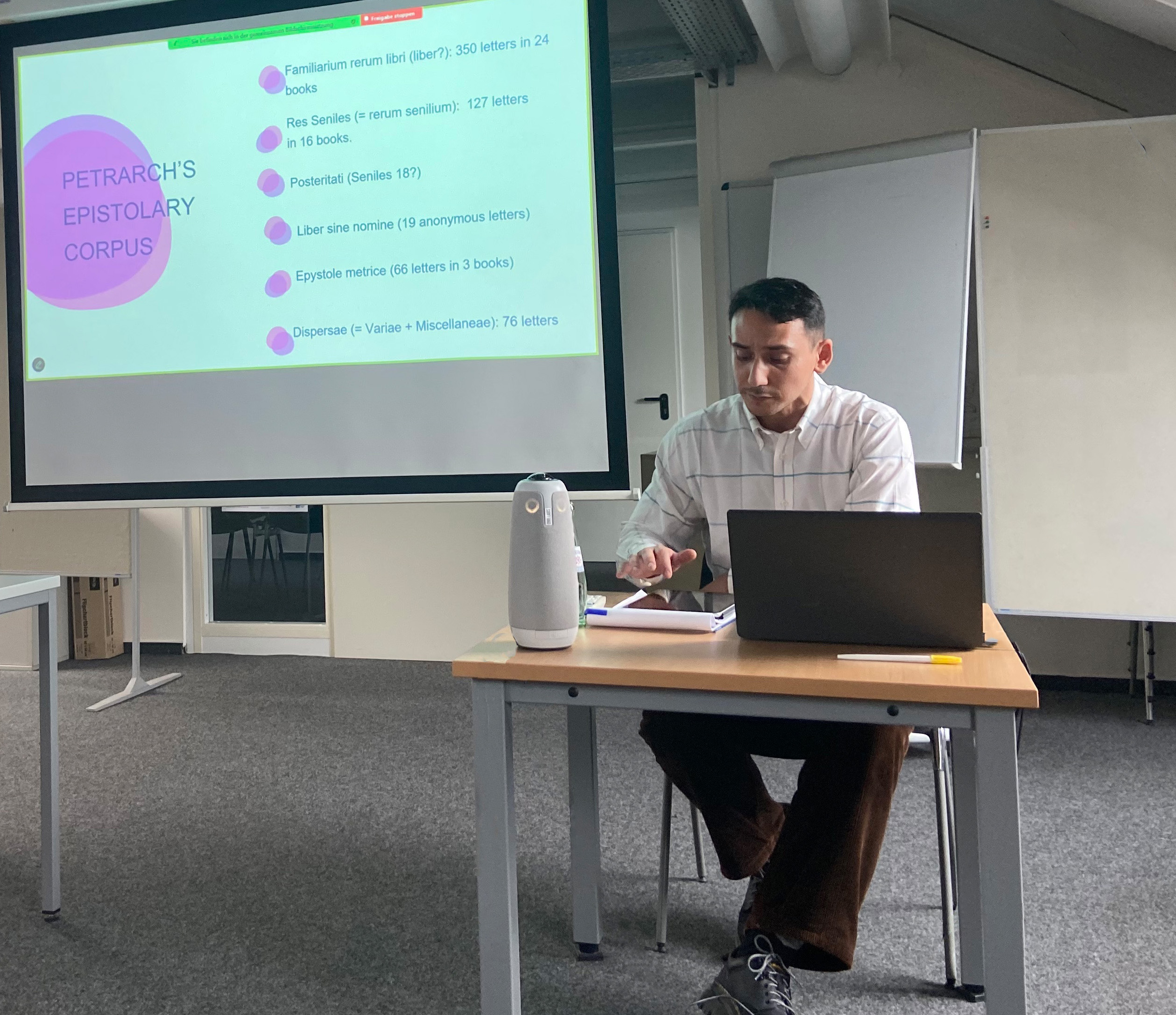
Álex Bermúdez Manjárres
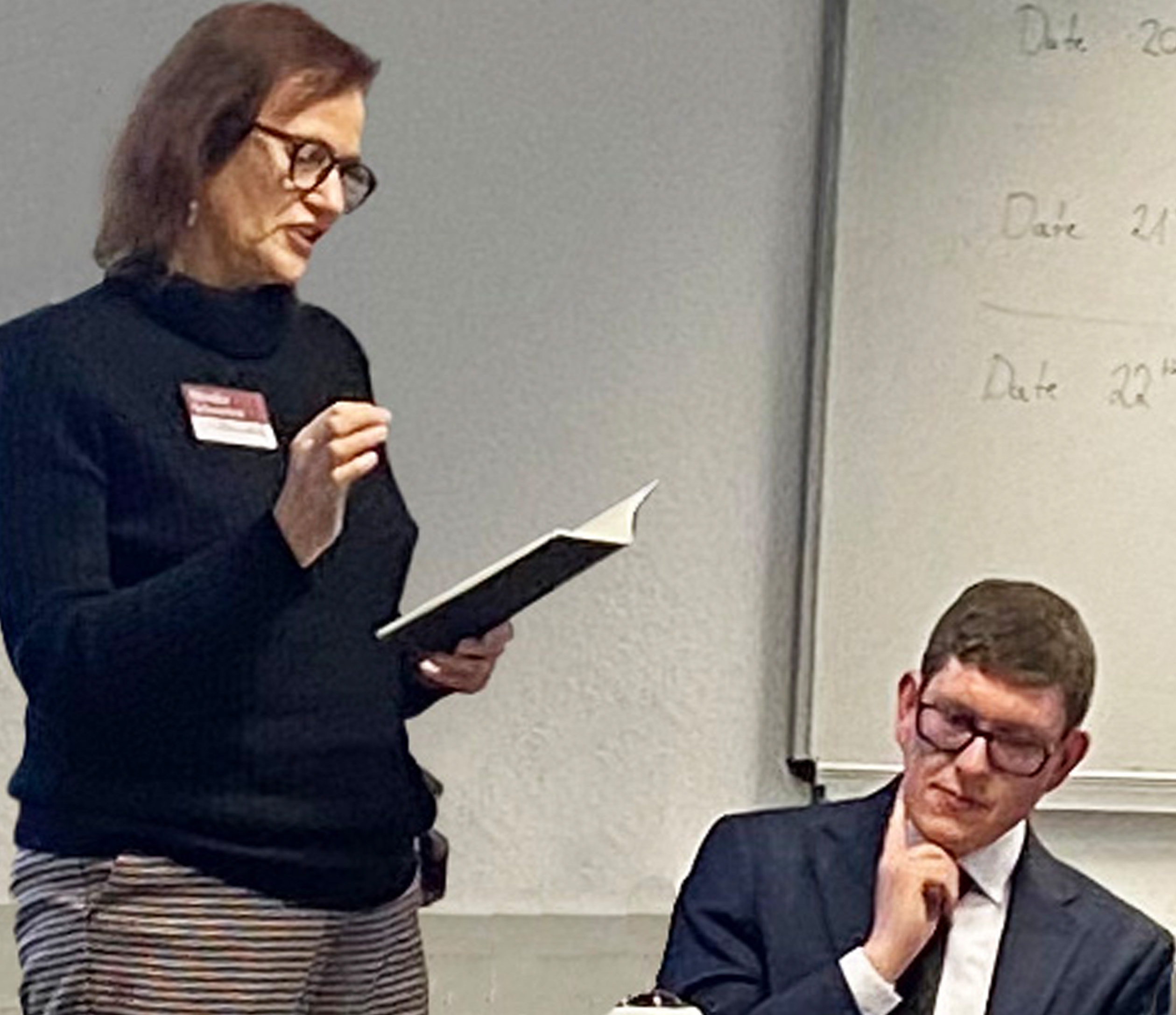
Monika Schausten and Greg Carrier
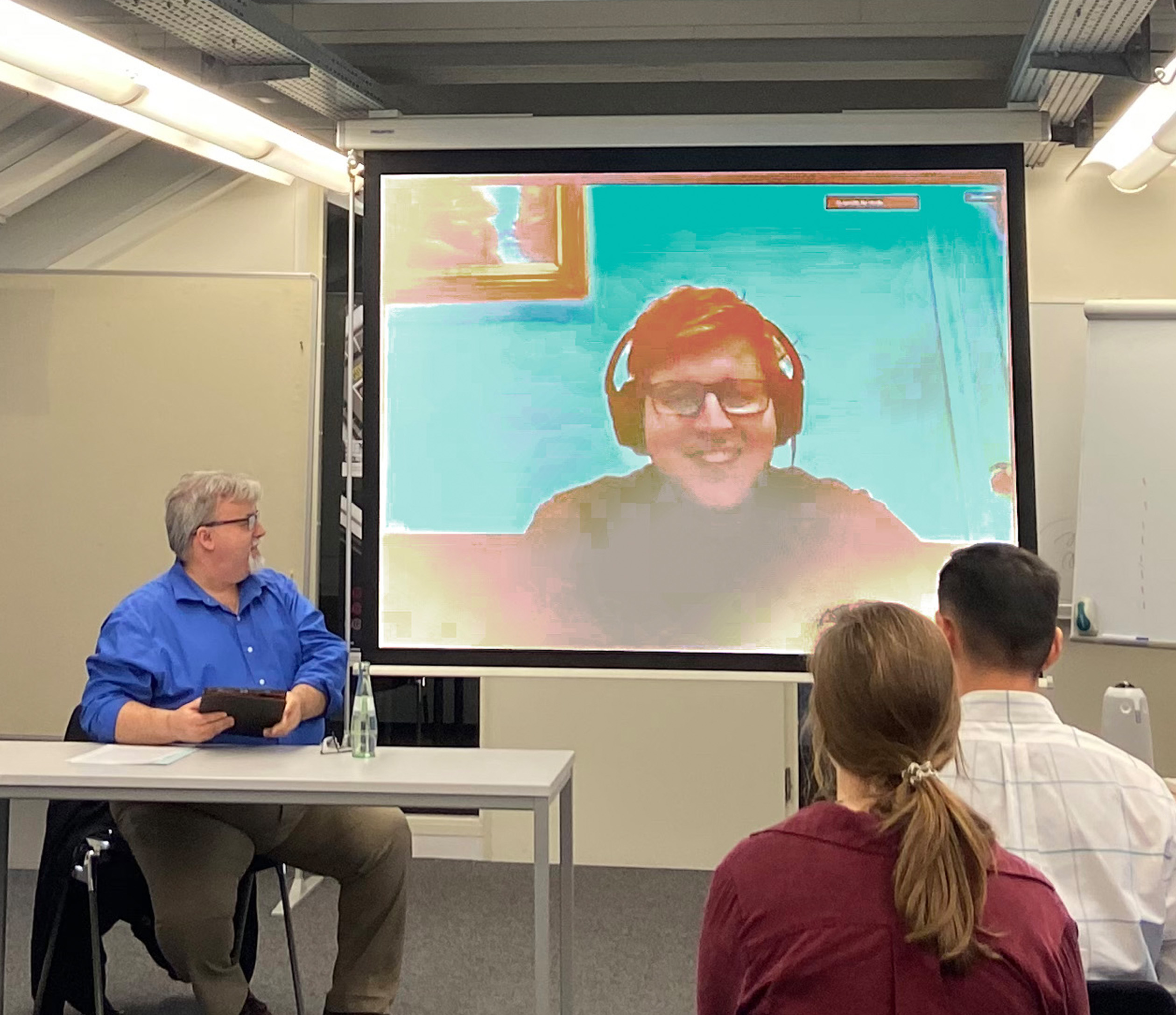
Jamie Collings and James Ginther

Andreas Speer and Rui Xu
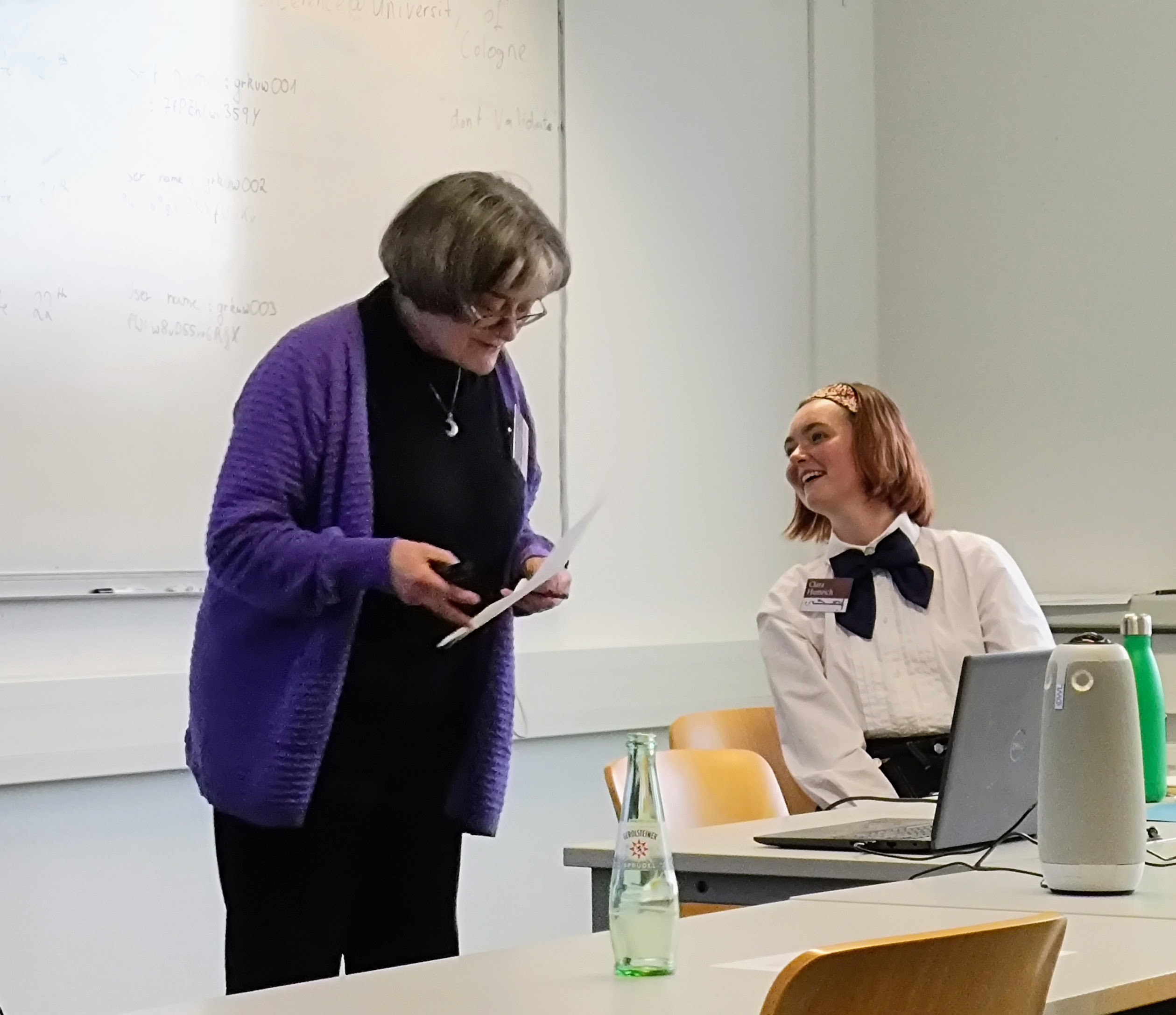
Dorothea Kullman and Clara
photos by Rui Xu and Álex Bermúdez Manjárres
Summer Latin
The Centre is internationally renowned for its Latin training and the high standard of Latinity retained by its students.
CMS offers three levels of Latin training held over the summer term for anyone looking to learn, refresh, or build on existing Latin skills.
The Centre offers Latin Examinations twice per year, open to students from U of T and external institutions. Results are sent directly to the candidate and to the candidate’s university department if requested. Successful students will be issued a “Statement of Proficiency” indicating their level of competency. CMS Summer Latin courses are available as preparation for these exams, or as standalone courses.
To learn more about CMS Latin Examinations, visit https://www.medieval.utoronto.ca/latin/medieval-latin-exams.
Visit https://www.medieval.utoronto.ca/latin/summer-latin-program/applying-summer-latin or contact Graduate Administrator Terry Louisy at gradadm.medieval@utoronto.ca for registration and more information.
Beginning Latin is an introductory course for those with little to no previous exposure to Latin. The course introduces declensions and conjugations, vocabulary and syntax, and is followed by a supplemental reading session that offers students an opportunity to consolidate their grasp of the language. Beginning Latin is open to any Student wishing to learn Medieval Latin, and is taught virtually.
Learning to read Latin is the closest we can get to hearing the voices of people who lived across multiple continents over almost twenty centuries. - John Schechtman-Marko
My approach to Latin teaching fosters wonder and confidence-building, and I strive to integrate principles of active language learning to help students develop fluency.
- Brianna Daigneault
Level I Latin encompasses Latin texts of various periods, countries of origin, and disciplinary interest, with emphasis on close grammatical commentary analysis. The course is preceded by Level I Latin Review, a grammar refresher session that precedes the practicum. Students who have completed Beginning Latin or another introductory course and have a basic knowledge of Latin elements may register for Level I Latin.
Latin is my passion, and through my teaching, I aim to show students that learning it is no more difficult than learning any other modern language.
- Álex Bermúdez Manjárres
I’m looking forward to teaching interesting texts relating to the unexpected miracles of a saint and lessons in avoiding the snares of the devil.
- Emma Gabe
Level II Latin coursework includes regular sight passages and prepared reading of Medieval Latin. This course prepares students to effectively use Latin for research purposes.
One cannot do responsible, grounded research on the Middle Ages without a solid foundation in Latin. Beyond that, it simply makes you really cool.
- Graham Johnson
Supervised by CMS Assistant Professor Cillian O'Hogan, these Summer Latin courses are facilitated by senior Graduate Students of the Centre who are thoroughly fluent in Latin and experienced Teaching Assistants and Course Instructors. They work under the supervision of the faculty members teaching Medieval Latin and are trained specifically for these courses, and will be available for regular consultation.
 John Schechtman-Marko
John Schechtman-Marko
Beginning Latin Instructor
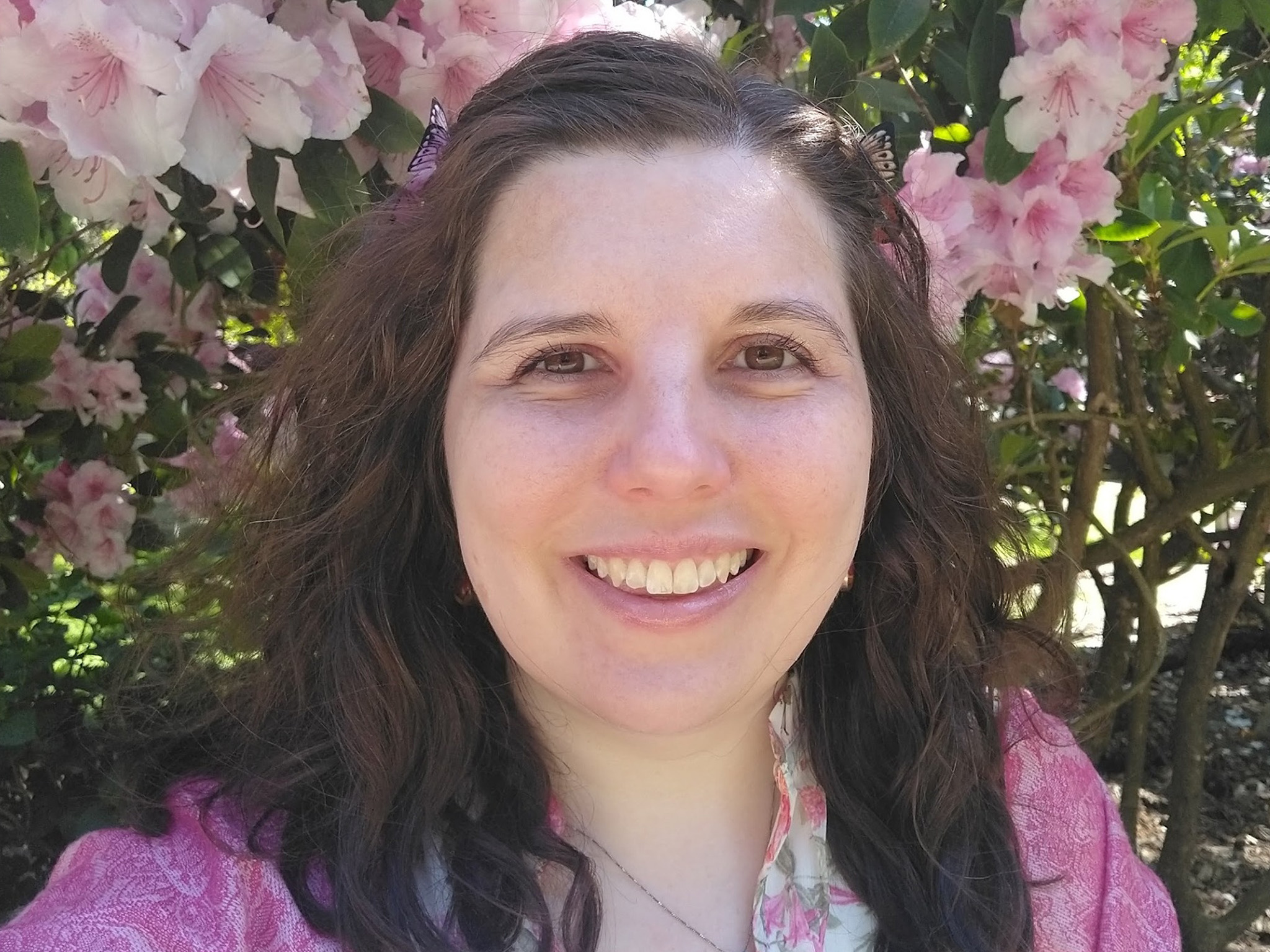
Brianna Daigneault
Beginning Latin Review Instructor
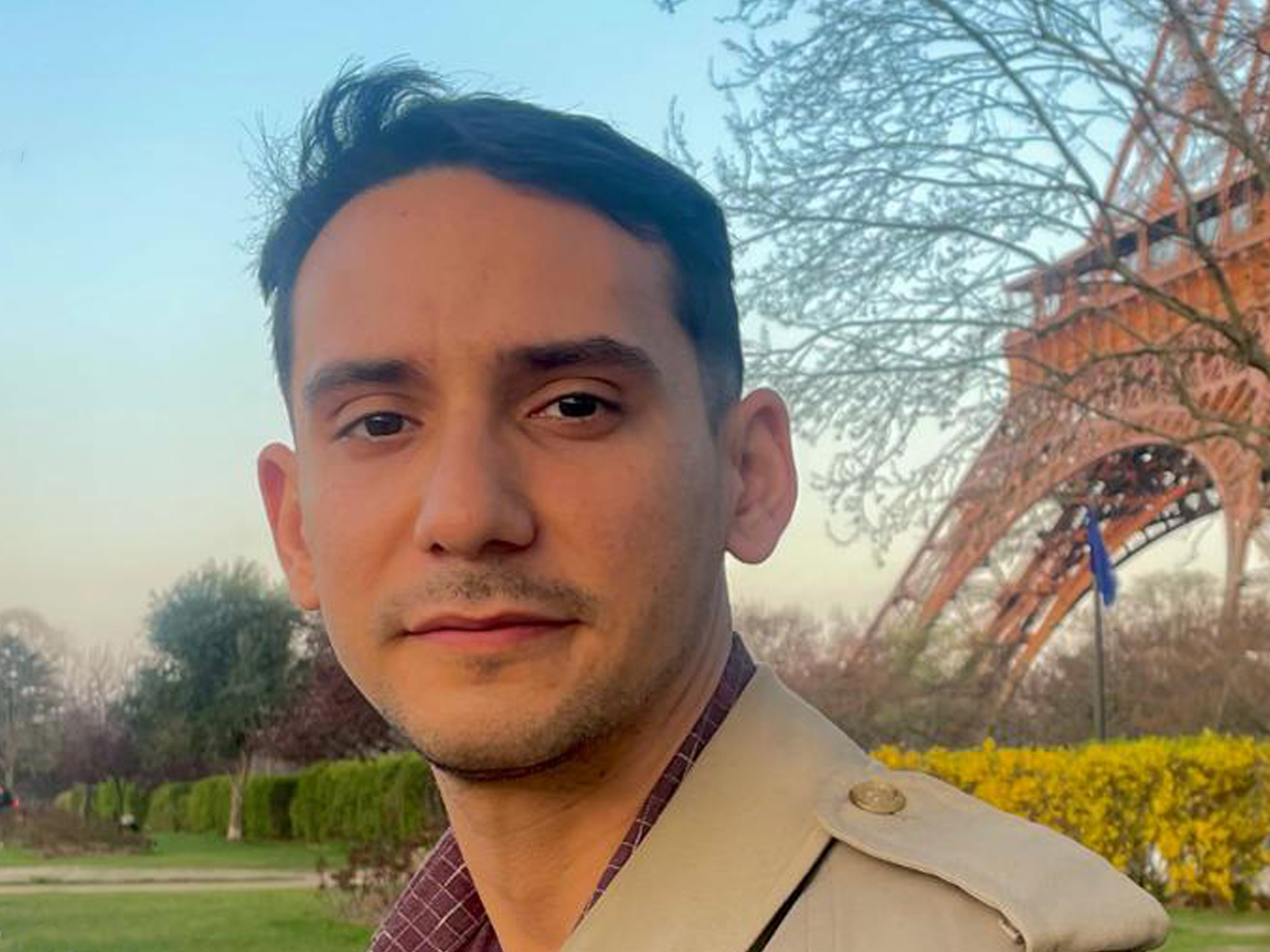
Álex Bermúdez Manjárres
Latin I Review Instructor
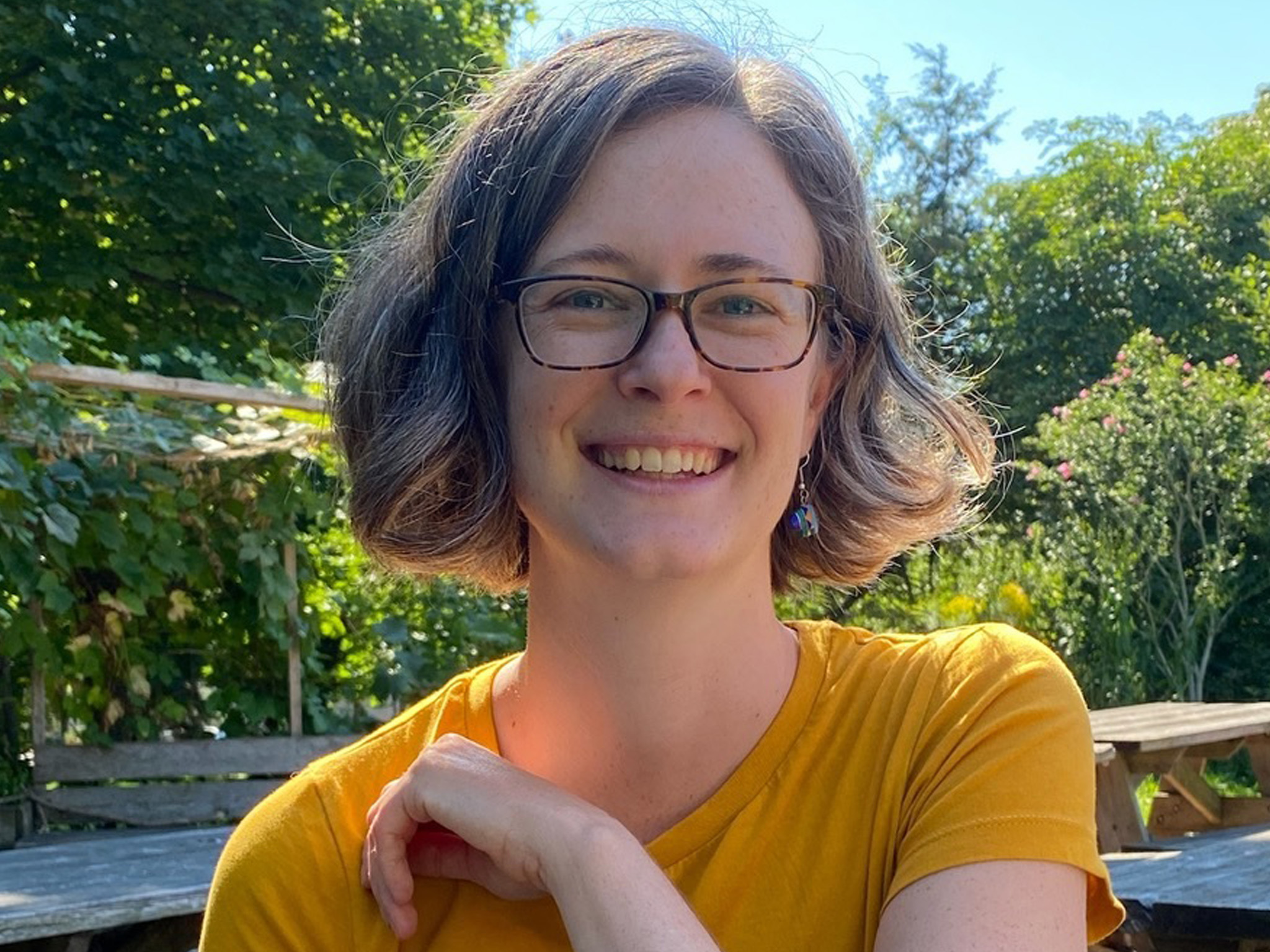
Emma Gabe
Latin Level I Instructor
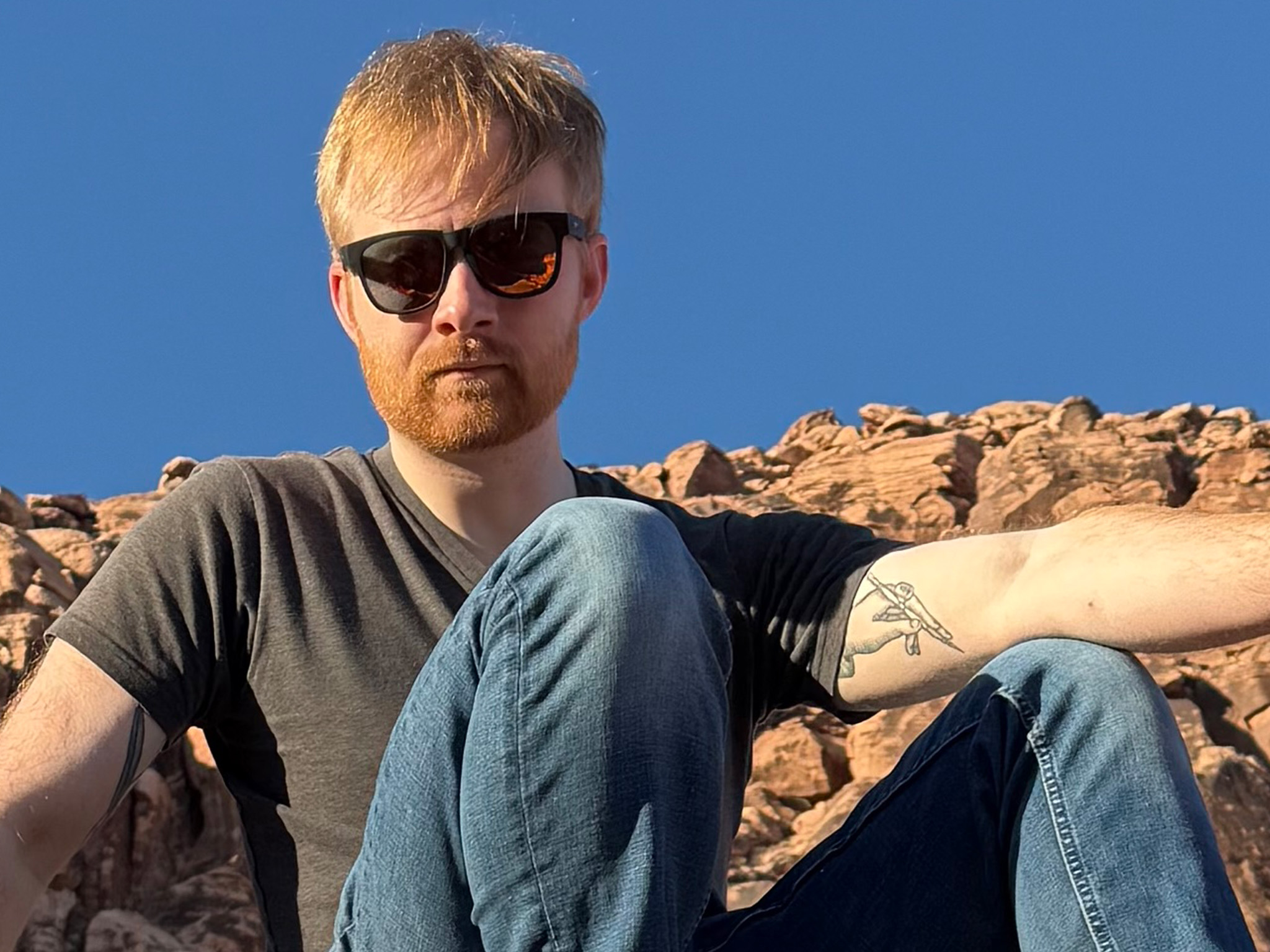
Graham Johnson
Latin Level II Instructor
Accomplishments
Publications
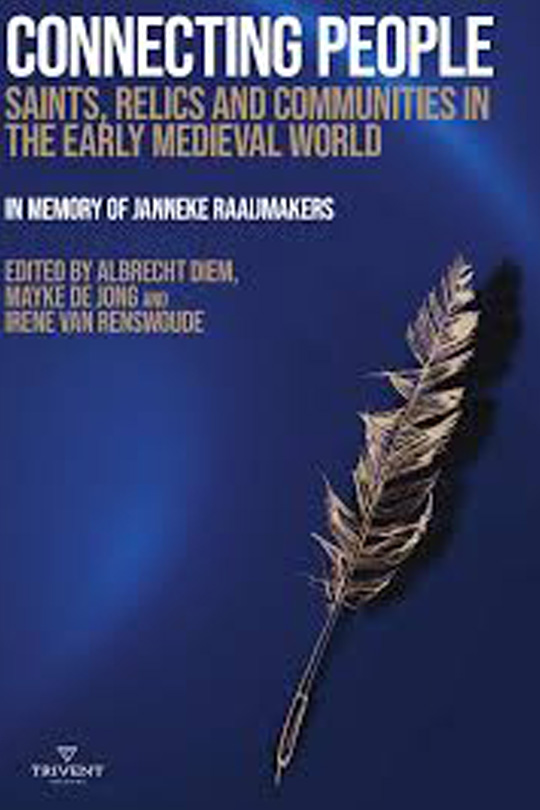
Edited by Albrecht Diem, Mayke de Jong, Irene van Renswoude • Connecting People, Saints, Relics and Communities in the Early Medieval World. In Memory of Janneke Raai-jmakers • Trivent Publishing

Luigi Guicciar-di, Translated by Edoardo Leone, Edited and Annotated by Konrad Eisenbichler • Jazz and Exile: Mario Fragiacomo, That Tin Trumpet from Italy’s East-ern Border • Club Giuliano Dalmato

Lisa Bennett, Helen Marshall, Kim Wilkins • Story Thinking and the Real-world Applications of Sci-Fi and Fantasy Writing • Blooms-bury Publishing
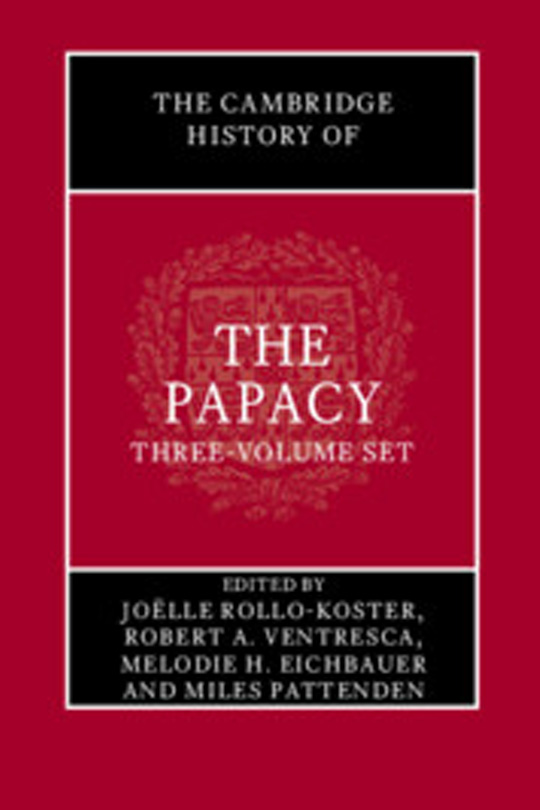
Edited by Joëlle Rollo-Koster, Robert A. Ven-tresca, Melodie H. Eichbauer, Miles Pattenden • The Cambridge History of the Papacy Three Volume Set • Cambridge University Press
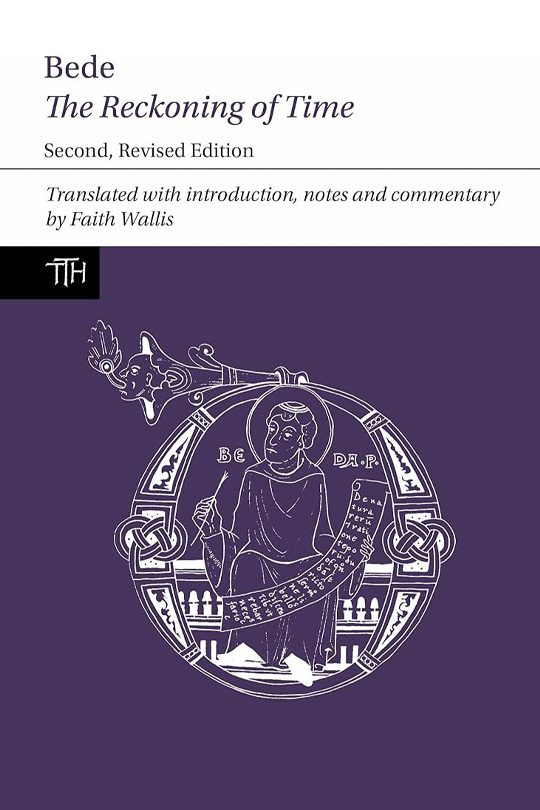
Faith Wallis • Bede: The Reckoning of Time (second edition) • Liverpool University Press
Congratulations
Student News
Phd Candidate Gregory Carrier was awarded the Inclusivity and Diversity Research Grant from the Medieval Academy of America in support of his research on the life and thought of Herman of Reichenau.
Phd Candidate Ariana Sider received a Doctoral Research Grant from the Centre for the Study of France and the Francophone World for her research on late medieval religiosity amongst lay publics in France.
Alumni News
Peter O’Hagan (PhD 2017) was appointed Assistant Professor in the Department of History at Christendom College.
Thomas Burman (PhD 1991) was honoured as a Medieval Academy of America Fellow, recognizing major long-term scholarly achievement within the field of Medieval Studies.
Laura Moncion (PhD 2024) was awarded a SSHRC Postdoctoral Fellowship at the Eberhard Karls Universität Tübingen Faculty of Philosophy’s Historical regional studies and historical auxiliary sciences.
Hannah Kirby Wood (PhD 2022) was awarded a SSHRC Postdoctoral Fellowship hosted by the University of Saskatchewan for a project titled “Arbiters of Charity: Courts of Law and the Female Poor in Late Medieval and Early Tudor England”.
Lectures & Events
Winter 2025

Associate Director, Jim Ginther and Director, Elisa Brilli represented CMS at St. Mike’s annual Graduate School Fair.

Current and past members of the Dictionary of Old English reunited at a Retirement celebration for Catherine Monahan. L-R Toni Healey, Stephen Pelle, Renée Trilling, Catherine Monahan, Robert Getz, Joan Holland, Cameron Laird, Elaine Quanz
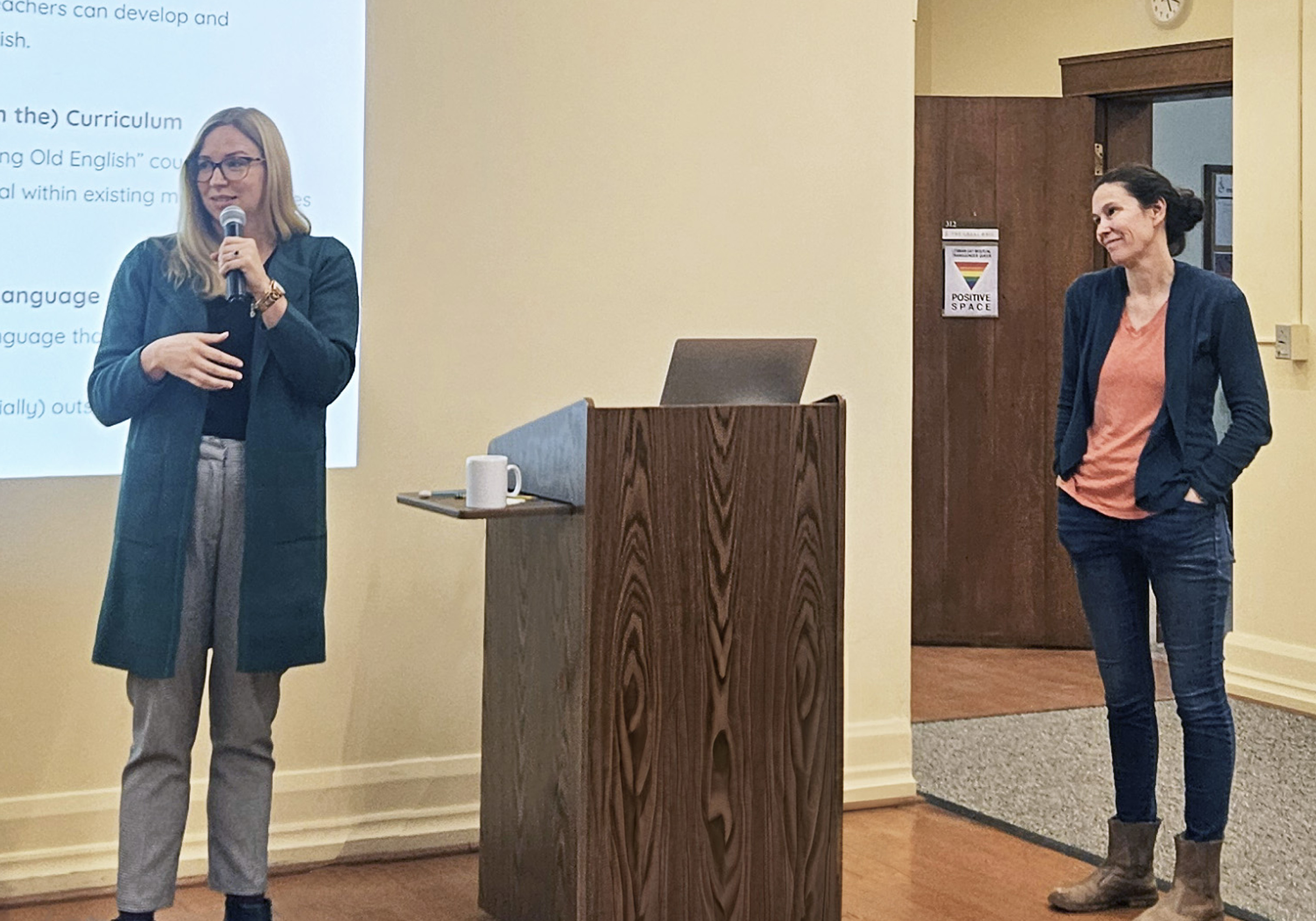
Trisha Teig (L) and Donna Beth Ellard from the University of Denver led the Old English stæfcræft and second-language acquisition methods: teaching Old English in a communicative, global context workshop for CMS and U of T educators.
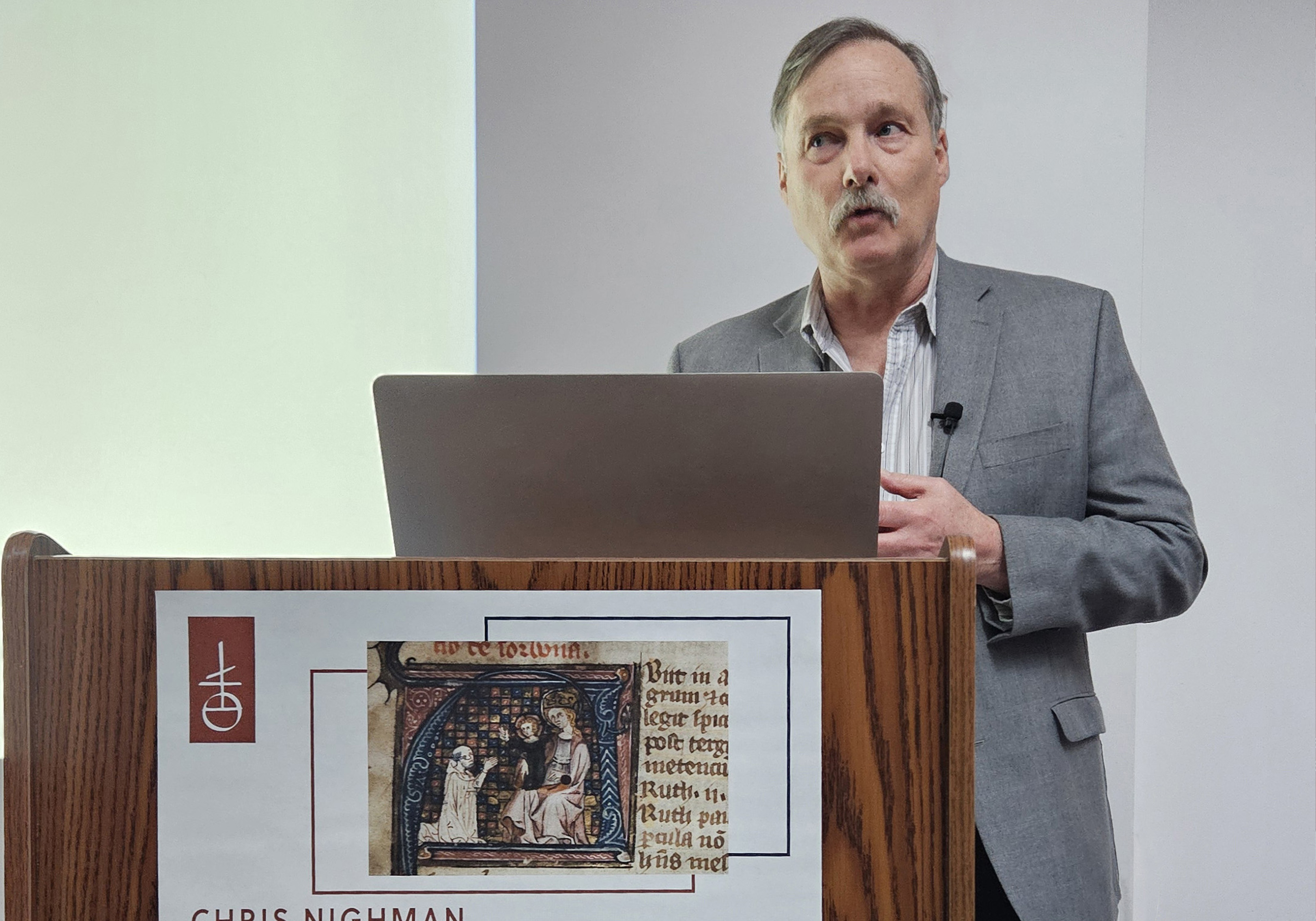
Chris Nighman’s ( Wilfrid Laurier / CMS ) presentation, Digital addenda / corrigenda for printed critical editions of Latin texts, took attendees on a virtual tour of his many detailed project websites, starting from the ‘Electronic Manipulus florum Project’ ( manipulus-project.wlu.ca ).

Jane Tylus (Yale University) presented Women as Witnesses: Grieving Mary in Medieval and Early Modern Europe at the CMS / CRRS joint Convivium.
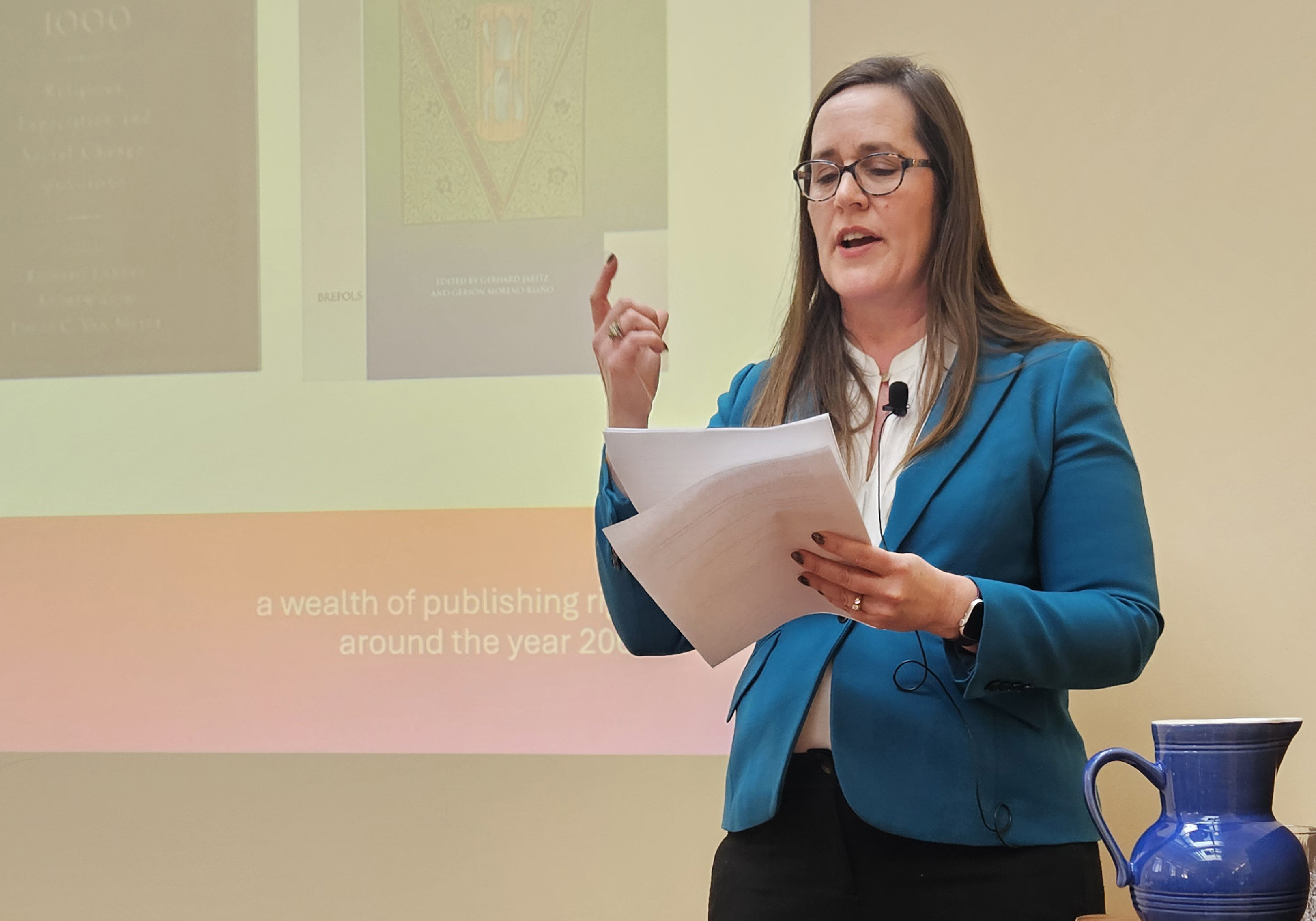
Rebecca Stephenson ( University College, Dublin ) presented The End of the World or merely another Viking raid? Vikings, the Apocalypse, and Byrhtferth’s Scientific Writing around the year 10005 during her stay at CMS as a Craig Dobbin Legacy Scholar.
Spring 2025
- April 4 - Annual Alumni Lecture, Anna Wilson (Harvard), The Past and Future of Medieval Studies in Ernest Wilkins' "Letter to Petrarch"
- April 11 - Annual O'Donnell Lecture with JMLAT hosted by Greti Dinkova-Bruun: Stella Panayotova (The Royal Library, Windsor) The Power of Latin: Text-image-concept Amalgams in Illuminated Manuscripts
REGISTER NOW - O'Donnell Lecture
- April 17 - Old English Colloquium, Janet Ericksen (University of Minnesota-Morris), Reading the Gaps in MS Junius 11
- and a symposium on the Poems of the Junius Manuscript
REGISTER NOW - Old English Colloquium
- April 25-25 - CSAMP Annual Toronto Workshop in Ancient Philosophy: Aristotle’s 'Parva Naturalia'
- May 30 - Épinal-Erfurt Glossary Colloquium: Early Latin-Old English Glossaries
LEARN MORE - Épinal-Erfurt Glossary Colloquium
- June 7 - Poculi Ludique Societas York Corpus Christi Plays 2025
Nominate yourself, a colleague, or a collaborative group to present at the 2025-2026 Convivium series.
2025-26 Convivium Nomination Form
In Memoriam
Walter André Goffart (1934-2025), Professor Emeritus, taught in the Department of History, U of T, from 1960 to 1999. His was a unique voice, at all times distinct and independent, illuminating and deeply important.
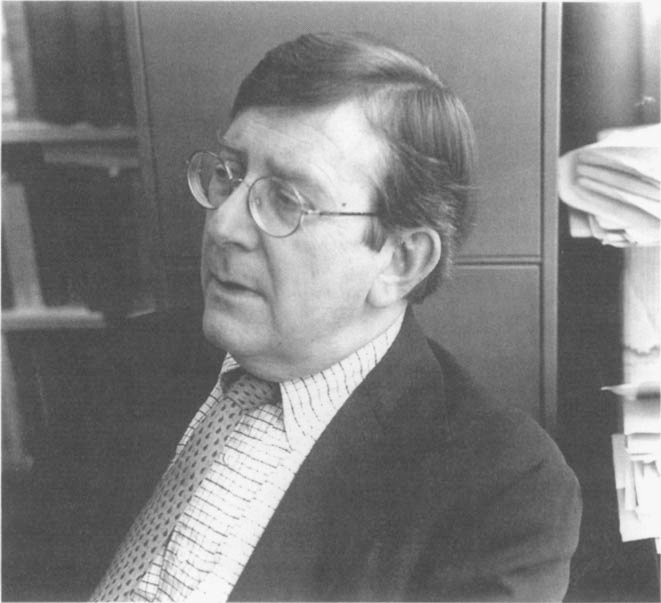
The son of a Belgian diplomatic family who escaped Europe for the US during WWII, Walter earned bachelor, master’s, and doctoral degrees from Harvard. He joined U of T History in 1960 and was one of the foundational faculty members of CMS, serving as Acting Director from 1971-1972. He was Fellow of the MAA, the Royal Historical Society, and the Royal Society of Canada, and in 1991 was awarded the MAA Haskins Medal. He held visiting fellowships at institutions throughout the world: Princeton, Dumbarton Oaks, the Newberry Library, Wisconsin, the Rockefeller Bellagio Centre, the Bogliasco Center, Oxford, Pretoria, Sydney, Jerusalem. He retired in 1999, presented with a Festschrift edited by his former student, Professor Emeritus Alexander Callander Murray. He was subsequently appointed as Senior Research Fellow and Lecturer at Yale, where his wife, Professor Roberta Frank (Director CMS 1994-1999), was Douglas Tracy Smith Professor of English (now Marie Borroff Professor Emeritus). Teaching until 2008, Walter continued to publish substantially; his works include seven monographs, two volumes of collected articles, thirty-seven journal articles (four in Speculum), twenty-eight book chapters, seventy-six book reviews, and translations from French or German for other scholars. Publishing his last monograph in 2020, he passed away a week short of his ninety-first birthday, and his final book chapter is forthcoming.
The mere weight of this cursus honorum does not convey the impress of Walter’s research. He is best known for three monographs, each recasting a topic fundamental to medieval historiography. Barbarians and Romans, A.D. 418-584: The Techniques of Accommodation (Princeton, 1980) shows how the Roman taxation system facilitated the settlement of the new regimes that usher in Medieval History, the mundane continuity masked by periodization of history. The Narrators of Barbarian History (A.D. 550-800): Jordanes, Gregory of Tours, Bede, and Paul the Deacon (Princeton, 1988) comprises four revolutionary monographs on our main sources for the sixth to eighth centuries, while more importantly teaching a mature methodology for analysing narrative texts. Historical Atlases: The First Three Hundred Years, 1570-1870 (Chicago, 2003), a vast compendium of data on early historical maps of medieval Europe, inaugurates critical analysis of this common form of historiography. Walter advocated “close reading” in his teaching, and his works display how far that simple formula could go.
In teaching and in supervision, Walter expected complete independence. When supervising, he gave enough rope, then wisely led away from trapdoors. He was generous and encouraging, and his insightful, practical advice has been passed on to every one of my own students, often verbatim.
I saw another measure of Walter, when he accepted an invitation to be a key-note speaker at a conference I co-organised in Sydney. Departmental politics meant that the only spare, good office was allocated to another invitee. Awkwardly, I showed Walter his space: a storeroom among the administrative staff, lined floor to ceiling by boxes of local publications, with a narrow path to a small desk. Walter didn’t turn a hair. Every weekday for a month, he bused into campus to work, and at lunch, he went on the hunt for postgraduates, undergraduates, or staff to talk with. If unsuccessful, he strolled off campus to indulge his odd passion for shopping mall architecture. By the end of the month, he had produced a fine, much-cited book chapter, among other work, and his presentation was the highlight of the conference. An attendee told me that, from her position mid-way up the auditorium, she could hear one senior scholar behind her, cheering, and watching the white knuckles of another in front. The good office went unused. Sometime after Walter and Roberta had returned home, I was visited in my office by Beth, the most junior member of the administrative staff, jaded by many international visitors over the years. She had come to thank me, earnestly and a little surprised, for having invited Walter. “He was so nice,” she said.
- Andrew Gillett (PhD 1994)
with thanks to Alexander Callander Murray, and Roberta Frank


